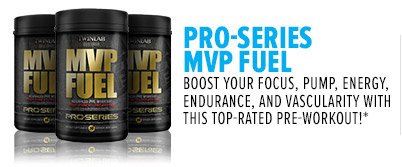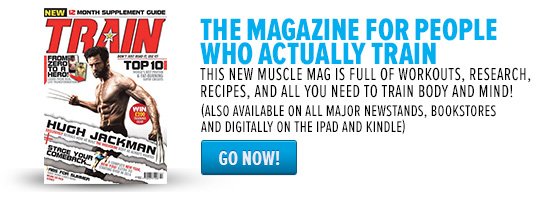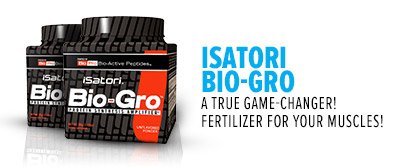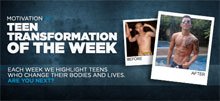We 'Mirin Vol 93: 20 Fitness Buddies
Jay Cutler's 10 Rules Of Never-Ending Growth


Four-time Mr. Olympia Jay Cutler is the everyman of the bodybuilding elite. Approachable, humble, and honest, he’s kind of like the guy next door… who just happens to weigh 280 pounds with near-zilch body fat.
True to form, if you meet Jay, he’s not going to blow your mind with round-the-campfire tales of epic workouts or cutting-edge tactics. In fact, his training routines are almost legendary for their extraordinary lack of novelty. He does more than lift things up and put them down, but not much.
On the other hand, this means that nary a second of Jay’s time in the gym over the years has been wasted. Few if any of us can say the same thing. So while fans may be hungry for his training and nutrition “secrets,” Jay is quick to point out it’s no secret at all.
Here are 10 of his most fundamental rules for maximizing your own physical potential while preserving your sanity.
Rule 1
You’re not likely to find Jay doing exotic exercises or using gimmicky equipment. In a montage of his workouts of the last 20 years, the haircuts would change more than the movements. You’d see him doing a lot of bench presses, squats, rows, pullovers, press-downs, and preacher curls. Why? They work.

You’re not likely to find Jay doing exotic exercises or using gimmicky equipment.
These six movements are almost foolproof mass-gain tools for even the most desperate of hard-gainers, as well as for someone with Jay’s peerless genetic makeup. That’s why you’ll find all of them throughout his Living Large 8-Week Mass-Building trainer. Rep ranges? The usual prescription of 8-12 for size is where the magic happens, in his opinion.
Rule 2
Conventional wisdom is that larger body parts need 12-16 sets of work in order to grow. But conventional wisdom doesn’t win four Olympias.
It’s not uncommon for Jay to perform 3-4 times that number of sets for a given body part—while never reaching failure, as he told us in the article “Lifelong Lessons on Building Mass.” He doesn’t do this as a shock tool; it’s a normal part of his routine. Where many other bodybuilders add reps and cut down on sets, Cutler says he prefers to go heavy for fewer reps, and add more sets. “You can’t do as many reps, or you’ll burn yourself out,” he says. This contributes greatly to the dense muscularity he has come to be known for.
Rule 3

“I need to make sure I get enough sleep,” (Jay) says. “That’s the most important thing.”
Beginners can get great results from full-body routines, but for advanced lifters there’s no substitute for a well-designed split. Longtime lifters know the quickest way to plateau is to fall in love with a single workout, bang it out, and then head back to the gym to do the same thing before you’ve had a chance to fully recover.
Jay insists on getting enough rest between sessions for the same body part, but grants that this is different for most people. What doesn’t vary between people is the importance of horizontal rest.
“I need to make sure I get enough sleep,” he says. “That’s the most important thing.”
Rule 4
The “rest as long as you need between sets” crowd may seem to make a compelling case. But their message falls on deaf ears when it comes to Jay. He rarely rests longer than a minute, even on his heaviest sets. It allows him to do more, live more, grow more, and eat more, staying both huge and ripped year-round.
He’s onto something. A study from the College of New Jersey reported that when men bench pressed with just 30 seconds of rest between sets, they burned over 50 percent more calories during the workout than when they rested 3 minutes.
Another from the University of Southern California, recently published in the “European Journal of Applied Physiology,” found that men who rested a minute between sets built more strength and size than men who rested four minutes.
Bigger, leaner, stronger—what are you waiting for? Get back to work.
Rule 5
Jay has never been shy about hitting a body part twice in a week if he feels the need. He has famously committed to twice-per-week back sessions, but with different focuses. One focuses on vertical pulls and deadlifts, and the other is heavy on horizontal pulls. This has helped him build a three-dimensional set of lats with show-stopping east-west development.
Rule 6
Competitive bodybuilders have to ruthlessly critique their physiques, because if there’s one thing they can be sure of, it’s that judges will do the same thing. Remember, Jay competed in six Mr. Olympia competitions before finally winning. And as he told us in “Big Lessons,” what he learned from these losses was what finally allowed him to win.
Years ago, realizing that his back and legs needed more fine-tuning in order to for him to stay competitive, he adjusted his training, going harder, heavier, and more often for these now lights-out muscle groups. The lesson for you: Physique athletes can’t afford to be sensitive. They need to attack weakness head-on.
Rule 7
The amount of bodybuilding information out there is growing exponentially. You can find more than you can read—and definitely more than you can use—about weight loads, volume, frequency, advanced techniques, and even training times.

Physique athletes can’t afford to be sensitive. They need to attack weakness head-on.
You might think that a world-class competitor like Jay stays up on all of this, and is always looking for tiny tricks to help maximize his performance. On the contrary, his primary guide is purely subjective—how he feels.
“I train whenever my body feels ready to train,” he says, ignoring the science that says late-day training yields better results. Jay adds that what works for you today may not work tomorrow.
Rule 8
Six sets of squats are scheduled, but your pins are toast after four. You’ve got meal number three in hand, but no microwave to cook it in. What to do? You do what you have to, no matter what you’re “supposed” to do.
While Jay feels it’s important to have a plan, he says you should never be so consumed with the routine that you can’t improvise. Though some might think this type of approach is a recipe for distraction, they don’t have Jay’s overall level of commitment. He says his approach helps him keep things fun and interesting in the gym, and that’s what has ultimately kept him coming back to the gym for decades.
Rule 9
Even if you don’t have any aspirations to be Mr. Olympia, you can still elicit tremendous changes in your body, health, and athletic performance by taking a winning approach to your food at home, at work, and even on the road.

“I tell people to put as much effort into their diet as they do into their weight training,” says Jay.
“I tell people to put as much effort into their diet as they do into their weight training,” says Jay. This type of mentality, he says, will yield new and drastic change for anyone—almost regardless of your goal.
Rule 10
In the last decade or so, bodybuilding judges have become consumed with identifying the best glute-ham tie-in on stage, making hamstring training more of a priority for competitors. But Jay and his peers are mostly seen—especially offstage—from the front. So train for balance, sure, but don’t forget that there’s no substitute for a monster set of quads.
Going through the motions with a few sets of squats, then skipping over to the leg extension machine isn’t going to cut it if your goal is to get ‘mired. Jay’s quad routine includes those staples, but incorporates the leg press, hack squat, front squat and walking lunges as well. Hit it from all angles, like in Jay’s toughest workout ever, and the results will be visible from all angles.
Recommended For You

Muscle By The Suitcase: Jay Cutler’s Fit Travel Guide
Jay Cutler didn’t win four Mr. Olympia titles by splurging on the road. Here’s his 5-step plan to navigate the challenges of living a clean, hard-training life when you’re away from home.

Jay Cutler: How I Survived My Toughest-Ever Workout
When you’re on top, everyone is gunning for you. How did Jay Cutler dominate competitive bodybuilding for five years? He trained harder than his rivals and won four Mr. Olympia titles.
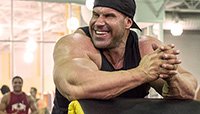
Jay Cutler: Big Lessons
In his long and illustrious bodybuilding career Jay Cutler has seen and done it all. The four-time Mr. Olympia gives us a frank assessment of what got him here and what lies ahead.
Taken from:
The Muscle Militia's Hardest Workouts Of The Year


Strength waits for no man. As the days grow shorter and the creatures of the wild seek refuge for a winter’s slumber, true iron animals dig deeper and get ready to drop bunker-busting efforts in the gym. What do you want to be: a hibernating bear cub or a top-of-the-food-chain weight smasher?
If you need to think it over, don’t bother. Just click over to TMZ, grab a 48-ounce soda, and nestle into that same old butt-groove on the couch. But if you’re ready to blow up like Krakatoa, then the Muscle Militia Generals have got just what you need to make it happen. Powerlifting freak Jason Wheat, bodybuilding Adonis Ronnie Milo, and shredded executive Chris Thompson have dug deep into their bags of tricks to deliver the most intense, badass workouts they’ve hit all year long.
The only common denominator: Each workout started off with a cruel idea and a scoop of Twinlab Pro-Series MVP fuel. Ready to get after it? Then set your dial to rage, drain a glass of MVP, load up Pantera on your playlist, and drop a text to your training partner to make a bro date. Just be sure to bring a towel, because you’re going to need it.
Meet the Muscle Militia

Ronnie Milo
Occupation:
Sales rep, Twinlab
Athletic Goal:
Competitive bodybuilder
“I want to be proportionate, work on my weak spots, and make sure I give 100 percent in the gym.”
Jason Wheat
Occupation:
Firefighter, Florida
Athletic Goal:
Powerlifter, coming back from pec injury
“My goal is to compete in powerlifting again.”
1 Ronnie Milo’s Weapon of Mass Construction

“Go a little lighter than your ego might want you to go,” (Milo) advises. “Listen to your body and err on the side of safety.”
For the majority of the year, Milo stays dialed in for competition and photo shoots, finely polishing the physique he works so hard to construct. When fall and winter come around, he can finally cut loose. We’re not talking mowing down bags of king-size Snickers bars here, though. For Milo, cutting loose means adding more clean calories to his normal macros and using that extra energy to really destroy himself. Fall is the time when he leans forward into big gains with this monstrous workout.
Like many experienced lifters, Milo doesn’t work off of percentage of max to calculate what to lift. Instead, he goes by feel. “When I get in for the first warm-up set, I know what I can get away with or can’t get away with,” he says. “I don’t like to tell people what to do at what weight. You need to listen to your body and find what’s safe and appropriate for you. Everyone is different, and people have variances in their body on where they’re strong and weak.”
That said, if you think you can tough-guy your way through this routine with a weight selected by your ego, Milo says to think again. “Go a little lighter than your ego might want you to go,” he advises. “Listen to your body and err on the side of safety.”
![Pullups]()
![Pullups]() Pullups
Pullups
3 warm-up sets of 12-15 reps-
Ronnie says: “That starts engaging the thicker lat muscles, and then I work into heavier movements.”
![Rack Pulls]()
![Rack Pulls]() Rack Pulls
Rack Pulls
3 sets to exhaustion (not failure)-
Ronnie says: “I do pulls from a Smith machine or squat rack and go 3/4 of the way down to engage the back, and not so much glutes and hamstrings. I don’t gauge the effort on numbers.”
![Wide-Grip Lat Pulldown]()
![Wide-Grip Lat Pulldown]() Wide-Grip Lat Pulldown
Wide-Grip Lat Pulldown
5 sets to exhaustion-
Ronnie says: “Start with the heaviest set first, and then drop the weight 10 percent each set. By the fifth set the pump is phenomenal.”
![One-Arm Dumbbell Row]()
![One-Arm Dumbbell Row]() One-Arm Dumbbell Row
One-Arm Dumbbell Row
5 sets to exhaustion-
Ronnie says: “Great for targeting your lats and getting a huge pump.”
![Dumbbell Flyes]()
![Dumbbell Flyes]() Dumbbell Flyes
Dumbbell Flyes
3 sets of 12-15 reps![Barbell Bench Press - Medium Grip]()
![Barbell Bench Press - Medium Grip]() Barbell Bench Press
Barbell Bench Press
5 sets of 6-8 reps![Dips - Chest Version]()
![Dips - Chest Version]() Weighted Dip
Weighted Dip
3 sets to failure-
Ronnie says: “By the time you get to these, you’ll be so cooked that you don’t think you’ve got another rep in you. Dig deep and bang them out.”
2 Jason Wheat’s Leg Quake Workout
The most epic workout Wheat threw down this year hit him so hard, he could literally barely walk for days afterward. “If you try this, just know that the volume is totally insane,” he warns. “Like ‘get out a straightjacket and call the funny farm’-type insane.”
So where did this sadistic vision come from? Wheat pulled this one out of the bag when a buddy challenged him to a day of total leg annihilation. “We were at Gold’s Gym in Orlando at a time when we were really getting into powerlifting,” he recalls. “We decided to switch it up for a day and really destroy it. We each had a packet of MVP beforehand, and boy did we ever need it.”

“If you try this, just know that the volume is totally insane,” (Wheat) warns. “Like ‘get out a straightjacket and call the funny farm’-type insane.”
Wheat recommends you use about 50 percent of your personal best for each lift. If you can breeze through this workout at that intensity, then call up an agent, because you’re ready to go pro.
-
Warm-up
![Jogging-Treadmill]()
![Jogging-Treadmill]() Light Cardio, Foam Rolling, and Dynamic Stretching
Light Cardio, Foam Rolling, and Dynamic Stretching
5 min-
Working Sets
![Leg Extensions]()
![Leg Extensions]() Leg Extensions
Leg Extensions
2 sets of 25 reps![Lying Leg Curls]()
![Lying Leg Curls]() Lying Leg Curls
Lying Leg Curls
8 sets of 8-12 reps![Barbell Squat]()
![Barbell Squat]() Barbell Squat
Barbell Squat
8 sets of 8-12 reps-
Jason says: “After your fifth or sixth set you can barely squat down. It feels absolutely brutal.”
![Leg Press]()
![Leg Press]() Leg Press
Leg Press
4 sets of 8-12 reps![Leg Extensions]()
![Leg Extensions]() Leg Extensions
Leg Extensions
6 sets of 25 reps-
Jason says: “After these, standing up will be hard. The worst part of the workout is doing the circuit after the legs. It just completely blows your mind.”
Finisher Circuit: 3 rounds
Aim to complete each round in under 90 sec.
![Bodyweight Squat]()
![Bodyweight Squat]() Air Squat
Air Squat
20 reps![Bodyweight Walking Lunge]()
![Bodyweight Walking Lunge]() Bodyweight Lunge
Bodyweight Lunge
20 reps per leg![Dumbbell Step Ups]()
![Dumbbell Step Ups]() Step Ups (Bodyweight)
Step Ups (Bodyweight)
20 reps per leg![Freehand Jump Squat]()
![Freehand Jump Squat]() Jump Squat
Jump Squat
20 reps-
Jason says: “This workout makes your body guess, and stimulates your muscles differently than a straight powerlifting workout. When you recover from it—which took me about a full week—you’ll have far greater muscular endurance.”
3 Chris Thompson’s Perfect Half-Hour Full-Body Circuit
Work starts early for busy executive Chris Thompson, but his workouts start even earlier. How early? On the day he had his toughest workout of the year, Thompson had a 6 a.m. flight to catch, so he got up, had two scoops of MVP, and dove straight into this circuit workout at 3 a.m. And he crushed it.
Unlike Milo’s and Wheat’s, Chris Thompson’s workout didn’t end up being a one-off or special occasion. It’s a workout so simple and awesome, he kept doing it all year long—and as a result, got leaner and more muscular than he’s ever been. Best part: it only takes 30 minutes.
Total-Body Muscle Militia Training
Watch The Video – 11:11
![Seated Leg Tucks]()
![Seated Leg Tucks]() Bench Tucks
Bench Tucks
1 set to failure![Standing Calf Raises]()
![Standing Calf Raises]() Calf Extension
Calf Extension
1 warm-up set of 8-15 reps
1 working set of 8-15 reps to failure-
Note(s): Warm-up sets are important because we’re going really heavy. Get those muscles warm before you work them hard.
![Thigh Abductor]()
![Thigh Abductor]() Abductor Machine
Abductor Machine
1 warm-up set of 8-15 reps
1 working set of 8-15 reps to failure![Hyperextensions (Back Extensions)]()
![Hyperextensions (Back Extensions)]() Hyperextensions
Hyperextensions
1 warm-up set of 8-15 reps
1 working set of 8-15 reps to failure![Lying Leg Curls]()
![Lying Leg Curls]() Hamstring Curl
Hamstring Curl
1 warm-up set of 8-15 reps
1 working set of 8-15 reps to failure![Leg Extensions]()
![Leg Extensions]() Leg Extensions
Leg Extensions
1 warm-up set of 8-15 reps
1 working set of 8-15 reps to failure![Squat Machine]() Squat Machine
Squat Machine
1 warm-up set of 8-15 reps
1 working set of 8-15 reps to failure![Pullups]()
![Pullups]() Pullups
Pullups
1 warm-up set of 8-15 reps
1 working set of 8-15 reps to failure![Seated Cable Rows]()
![Seated Cable Rows]() Seated Cable Rows
Seated Cable Rows
1 warm-up set of 8-15 reps
1 working set of 8-15 reps to failure![Side Lateral Raise]()
![Side Lateral Raise]() Dumbbell Lateral Raise
Dumbbell Lateral Raise
1 warm-up set of 8-15 reps
1 working set of 8-15 reps to failure![Dumbbell Bicep Curl]()
![Dumbbell Bicep Curl]() Dumbbell Bicep Curl
Dumbbell Bicep Curl
1 warm-up set of 8-15 reps
1 working set of 8-15 reps to failure![Barbell Bench Press - Medium Grip]()
![Barbell Bench Press - Medium Grip]() Barbell Bench Press – Medium Grip
Barbell Bench Press – Medium Grip
1 warm-up set of 8-15 reps
1 working set of 8-15 reps to failure-
Note(s): A couple of us have had significant shoulder injuries that we’re still rehabilitating, which is why we don’t perform full repetitions. If your shoulders are healthy, do full reps.
![Dips - Triceps Version]()
![Dips - Triceps Version]() Weighted Dip
Weighted Dip
1 warm-up set of 8-15 reps
1 working set of 8-15 reps to failure
“I do this workout almost exclusively. It is what I consistently do, whether I’m at home, in a hotel gym, or anywhere,” he says. “You can find a way to modify this workout to work no matter what equipment you have. The true key is achieving physical failure with every exercise.”
On a day when he had to drag himself out of bed at a time many dudes are just getting home from a bar, Thomspon showed up, made it happen, and got the results he wanted—all before the sun crept up. Want to feel unstoppable for the whole day? Start with the hardest challenge, and watch as everything else in your life falls into line.
Recommended For You
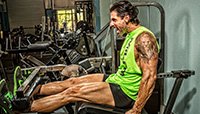
Full-Body Training: Twinlab Militia 30-Minute Workout
This Twinlab Muscle Militia workout may only last 30 minutes, but it’s a full-body bomb that will challenge each of your major muscle groups to grow. Give it a shot today!

Muscle Manifesto: 5 Principles Of The Lifting Life
A PR is great, but it’s just a number. Strengthen your life from the bottom up, and your lifts will grow alongside it!
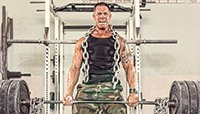
Muscle Militia Mindset: 5 Must-Read Mental Intensity Tips
Long-term progress requires consistent mental focus. Build intensity that lasts with these five tips from the Twinlab Muscle Militia!
View the original here:
Reverse-Pyramid For Size And Strength


The methodology for this program is based on linear periodization but with a key alteration. Instead of just a steady progression in the amount of weight used, there is a wave system built into the program. The reason for this waving, or undulation, in intensity is twofold. It prevents overtraining by providing periodic deloads at key intervals, and it also allows for greater length of time of progression in the amount of weight lifted. If you were to just steadily increase the amount of weight used from week to week, it wouldn’t be long before your progress stalled. The wave technique provides us with the ability to continually progress for a much longer period of time before we reach a plateau.
There is an additional unusual element to this program. The main exercises (squats, benches, and deadlifts) are performed by inverting the relationship between set and intensity progression. Stated plainly: as the sets progress, there is a small decrease in the amount of weight used, instead of the usual increase. The purpose of this is to allow the lifter to perform every set in good form and to ensure that the lifter never misses a rep in training, even as the amount of weight increases from week to week. Contrary to popular belief, training to failure and beyond is not always desirable when trying to build strength. When programmed properly, not missing reps in training can be a key ingredient to building strength—and as we know, gaining strength is a vital component to gaining size.

“The exercise selection is based largely on multijoint compound movements.”
The exercise selection is based largely on multijoint compound movements. As many of you probably already know, these types of exercises allow us to use more weight, which in turn yields greater muscle-fiber recruitment, which ultimately leads to a greater degree of muscular hypertrophy. Another key element to gaining mass is ensuring a large volume of blood is being forced into the muscle while training. More commonly known as the “pump” because of the way your muscles swell while lifting, the pump is often synonymous with an increase in muscle size. A good pump stretches the connective tissue that surrounds the muscle fibers, allowing room for new growth. Arnold was often quoted as saying that a good pump means you’re growing, and he was right. This program achieves a massive pump both through overall training volume (a relatively high number of sets and/or reps) and through specific exercises done for higher rep ranges with shorter rest periods. For example, dumbbell rows, front squats, and barbell shrugs are all performed for sets of twenty reps but are still performed with relatively heavy weights, which, when combined with minimal rest periods, provides us with a high volume of blood being forced into the muscle. There are other methods used to achieve this, like the shoulder complex, which is a triset of three different exercises, all performed back-to-back without rest. By the end of your third triset, your shoulders will be blown up like balloons.
You will be training five days a week, and Thursday and Sunday will be the off days. Splitting things up into five days allows us to hit the individual muscles with sufficient volume during the training session without doing marathon workouts. The order of the individual training sessions ensures that there will be sufficient recovery time before the same muscles are trained again. It breaks down like this:
Monday: Lower back, hamstrings, and calves
Tuesday: Chest and shoulders
Wednesday: Upper back
Thursday: Off
Friday: Legs
Saturday: Biceps and triceps
Sunday: Off
After warming up, deadlifts, bench presses, and squats are performed for five sets of five reps with the weight selection in accordance with the weight progression percentages listed at the end of this chapter. You will be required to find your maxes on these exercises before beginning this program so you can plug the correct numbers into the formula. One word of caution here: do not guess your maxes. Overestimating them will lead to an inability to achieve the desired number of reps and to overtraining, ultimately resulting in a failure of the entire program.
The wave technique comes into play with the main exercises (squats, bench presses, and deadlifts). The amount of weight used will increase over each three-week wave. The fourth week will consist of a deload week, during which the amount of weight used will be substantially decreased to facilitate recovery and prevent overtraining. Then, the next wave begins. However, don’t be fooled into thinking that the deload weeks will be easy. While the amount of weight used decreases, the amount of reps performed doubles, ensuring that you will still be working hard and stimulating growth even while preventing overtraining. The overall program length is written for sixteen weeks, which is comprised of four waves. At the end of the sixteen weeks, you will then find your new maxes, and, if you desire, you can plug them back into the table and begin the program again.
Rest periods should be kept to no more than five minutes maximum on the large compound movements like squats, bench presses, and deadlifts and at no more than two to three minutes for more isolation-type exercises like spider curls and pushdowns. This will ensure adequate recovery between sets but still provide you with the huge pump that you are looking for. If you are able to achieve all of the desired reps in good form for the assistance movements (everything besides squats, bench presses, and deadlifts), increase the weight by a small amount for the following week. On these exercises, we are not as concerned about missing an occasional rep because of achieving muscular failure as we are for squats, bench presses, and deadlifts.
TRAINING PROGRAM
![Barbell Deadlift]()
![Barbell Deadlift]() Barbell Deadlift
Barbell Deadlift
Warm up, then follow weight progression at the end of the chapter![Pull Through]()
![Pull Through]() Pull Through
Pull Through
3 × 20![Lying Leg Curls]()
![Lying Leg Curls]() Lying Leg Curls
Lying Leg Curls
2 × 10![Seated Leg Curl]()
![Seated Leg Curl]() Seated Leg Curl
Seated Leg Curl
2 × 10![Standing Calf Raises]()
![Standing Calf Raises]() Standing Calf Raises
Standing Calf Raises
4 × 25
![Barbell Bench Press - Medium Grip]()
![Barbell Bench Press - Medium Grip]() Barbell Bench Press
Barbell Bench Press
Warm up, then follow weight progression at the end of the chapter![Barbell Incline Bench Press - Medium Grip]()
![Barbell Incline Bench Press - Medium Grip]() Barbell Incline Bench Press
Barbell Incline Bench Press
Pyramid up in weight sets of 12, 10, 8, 6![Dips - Chest Version]()
![Dips - Chest Version]() Dips
Dips
Pyramid up in weight sets of 15, 12, 10, 8![Standing Military Press]()
![Standing Military Press]() Standing Military Press
Standing Military Press
Pyramid up in weight sets of 10, 8, 6-
Shoulder complex: repeat circuit 3 times without any rest between exercises
![Front Dumbbell Raise]()
![Front Dumbbell Raise]() Front Dumbbell Raise
Front Dumbbell Raise
20 reps![Side Lateral Raise]()
![Side Lateral Raise]() Side Lateral Raise
Side Lateral Raise
20 reps![Seated Bent-Over Rear Delt Raise]()
![Seated Bent-Over Rear Delt Raise]() Seated Bent-Over Rear Delt Raise
Seated Bent-Over Rear Delt Raise
20 reps
![One-Arm Dumbbell Row]()
![One-Arm Dumbbell Row]() Kroc Row
Kroc Row
2 × 20, go as heavy on these as possible![Chin-Up]()
![Chin-Up]() Chin-Up
Chin-Up
50 reps total with body weight, in as many sets as it takes; rotate between 2 to 3 different grips![T-Bar Row with Handle]()
![T-Bar Row with Handle]() T-Bar Row with Handle
T-Bar Row with Handle
Pyramid up in weight sets of 12, 10, 8, 6![Wide-Grip Lat Pulldown]()
![Wide-Grip Lat Pulldown]() Wide-Grip Lat Pulldown
Wide-Grip Lat Pulldown
Pyramid up in weight sets of 15, 12, 10, 8![Barbell Shrug]()
![Barbell Shrug]() Barbell Shrug
Barbell Shrug
2 × 20 reps, as heavy as possible

Kroc Row
![Barbell Squat]()
![Barbell Squat]() Barbell Squat
Barbell Squat
Warm up, then follow weight progression at the end of the chapter![Leg Press]()
![Leg Press]() Leg Press
Leg Press
Pyramid up in weight for sets of 15, 12, 10, 8![Front Barbell Squat]()
![Front Barbell Squat]() Front Barbell Squat
Front Barbell Squat
2 × 20![Barbell Walking Lunge]()
![Barbell Walking Lunge]() Barbell Walking Lunge
Barbell Walking Lunge
2 × 30 steps![Seated Calf Raise]()
![Seated Calf Raise]() Seated Calf Raise
Seated Calf Raise
4 × 25
![Close-Grip Barbell Bench Press]()
![Close-Grip Barbell Bench Press]() Close-Grip Barbell Bench Press
Close-Grip Barbell Bench Press
Pyramid up in weight sets of 10, 8, 6![EZ-Bar Skullcrusher]()
![EZ-Bar Skullcrusher]() EZ-Bar Skullcrusher
EZ-Bar Skullcrusher
Pyramid up in weight sets of 12, 10, 8![Triceps Pushdown]()
![Triceps Pushdown]() Triceps Pushdown
Triceps Pushdown
Pyramid up in weight sets of 15, 12, 10![Bench Dips]()
![Bench Dips]() Bench Dips
Bench Dips
3 × 20![Barbell Curl]()
![Barbell Curl]() Barbell Curl
Barbell Curl
Pyramid up in weight sets of 15, 12, 10![Preacher Curl]()
![Preacher Curl]() Preacher Curl
Preacher Curl
Pyramid up in weight sets of 15, 12, 10![Incline Dumbbell Curl]()
![Incline Dumbbell Curl]() Incline Dumbbell Curl
Incline Dumbbell Curl
Pyramid up in weight sets of 15, 12, 10![Spider Curl]()
![Spider Curl]() Spider Curl
Spider Curl
3 × 20
Weight Progression For Squats, Bench Presses, And Deadlifts |
Week 1:5 × 80%, 5 × 77.5%, 5 × 75%, 5 × 72.5%, 5 × 70% |
Week 2:5 x 82.5%, 5 x 80%, 5 x 77.5%, 5 x 75%, 5 x 72.5% |
Week 3:5 x 85%, 5 x 82.5%, 5 x 80%, 5 x 77.5%, 5 x 75% |
Week 4:Deload, squats and bench presses 5 x 10 at 60%; no deadlifts |
Week 5:5 x 82.5%, 5 x 80%, 5 x 77.5%, 5 x 75%, 5 x 72.5% |
Week 6:5 x 85%, 5 x 82.5%, 5 x 80%, 5 x 77.5%, 5 x 75% |
Week 7:5 x 87.5%, 5 x 85%, 5 x 82.5%, 5 x 80%, 5 x 77.5% |
Week 8:Deload, squats and bench presses 5 x 10 at 60%; no deadlifts |
Week 9:5 x 85%, 5 x 82.5%, 5 x 80%, 5 x 77.5%, 5 x 75% |
Week 10:5 x 87.5%, 5 x 85%, 5 x 82.5%, 5 x 80%, 5 x 77.5% |
Week 11:5 x 90%, 5 x 87.5%, 5 x 85%, 5 x 82.5%, 5 x 80% |
Week 12:Deload, squats and bench presses 5 x 10 at 60%; no deadlifts |
Week 13:5 x 87.5%, 5 x 85%, 5 x 82.5%, 5 x 80%, 5 x 77.5% |
Week 14:5 x 90%, 5 x 87.5%, 5 x 85%, 5 x 82.5%, 5 x 80% |
Week 15:5 x 92.5%, 5 x 90%, 5 x 87.5%, 5 x 85%, 5 x 82.5% |
Week 16:Deload, squats and bench presses 5 x 10 x 60%; no deadlifts |
Week 17:Find new maxes on squat, bench presses, and deads |
From Insane Training: Garage Training, Powerlifting, Bodybuilding, and All-Out Bad-Ass Workouts. Copyright © 2014 by Matt Kroczaleski, reprinted with permission of St. Martin’s Press, LLC.
Recommended For You

AMP: Marc Megna’s 8-Week Aesthetics Meets Performance Trainer
The 8-week AMP program will help you perform like a pro and look even better. It’s the ultimate combination of aesthetics and performance. Get amped to reach your physical peak.

Working Class Man: Marc Megna Workout
There are a million reasons why Muscletech performance
coach Marc Megna shouldn’t be living his dreams. But
they’re not stopping him.

Fitness 360: Marc Megna, Dream Big, Never Quit
Marc Megna played in the NFL and coached pro athletes after he left the game. Now, he’s an elite trainer and fitness model. Follow his fitness plan!
See original:
Novice Lifters, Start Here!


The phrase “Starting Strength” (SS) has two distinct meanings:
-
The first is the title of the best-selling book, “Starting Strength: Basic Barbell Training,” 3rd edition, by Mark Rippetoe.
-
The second is the Starting Strength Novice Program (aka the “Starting Strength Linear Progression”).
PROGRAM OVERVIEW
While the program appears in the book, the book itself is much more than simply a description of the Starting Strength program. “Starting Strength: Basic Barbell Training” provides an in-depth, thorough analysis of the five primary barbell lifts: squat, deadlift, press, bench press, and power clean/power snatch.
Correct form is derived through analysis and application of functional anatomy, biomechanics, and physics. How to utilize this correct form is then distilled into easy-to-follow instructions that make the complexities of the lifts as easy to execute as possible.

Correct form is derived through analysis and application of functional anatomy, biomechanics, and physics.
This guide focuses more on the program aspect of Starting Strength. There is no substitute or shorthand method to convey the analysis, model, and method found in the book. “Starting Strength” is the only work of its kind. No other resource delves as seriously and deeply into the background and application of technique for the primary barbell lifts and how to correct deviations from proper technique.
Doing the Starting Strength Program without using the Starting Strength Lifting Model and Method will work, but not nearly as well as using both together. It is therefore highly recommended that you purchase and read the book before beginning the Starting Strength Program.
WHY DO STARTING STRENGTH?
The Starting Strength Program is the best program for a novice to develop the strength that will serve as the basis for all future training, as well as increase performance in life and sports. Developed by Mark Rippetoe and refined over decades of experience coaching thousands of trainees, the Starting Strength Program allows trainees to make faster strength gains during their first serious period of training than any other program.

The Starting Strength Program allows trainees to make faster strength gains during their first serious period of training than any other program.
The Starting Strength Program is an appropriate place to start for nearly all trainees new to serious strength training. Whether the long-term goal is powerlifting, general health and fitness, or training for sport, the program will provide the training base necessary to succeed and excel at any and all of those endeavors.
The Starting Strength Program’s beauty is its simplicity. You need only perform and master five basic barbell exercises, plus chin-ups, to complete this program. It is cost-effective for those who prefer to purchase their own equipment and work out at home. It is also time-efficient, since you don’t need to perform a lot of isolation or assistance work.
With that introduction, let’s get to the actual program.
STARTING STRENGTH
The Starting Strength Program can be broken down into two workout days: Day A and Day B.
The entire body is worked each session. As the trainee progresses through the program, Days A and B are slightly modified to take into account the adaptations in the body of the lifter.
The goal of this program is to add weight each and every time you lift, taking advantage of The Novice Effect that allows you to do so. Perform the program 3 days per week, on non-consecutive days (e.g., Monday/Wednesday/Friday, Tuesday/Thursday/Saturday).
Most healthy men between the ages of 18 and 35 can add 10 pounds to the squat the first 2-3 times it’s performed, 15-20 pounds to the deadlift the first couple times, and 10 pounds the next several times it’s performed. After that, jumps become 5 pounds per workout. For the press, bench press, and power clean, you may get one 10-pound jump, but you may need to start with 5-pound jumps. Later on, you’ll move to 2.5 pound jumps or smaller for these lifts when 5 pounds becomes too much to add every workout.

Barbell Squat
Most women (and men over 35) will begin with smaller jumps—perhaps a single 10-pound jump in the squat, two or three 10-pound jumps in the deadlift, and immediate 5-pound jumps in the other exercises—then proceed to 2.5 pounds or smaller incremental increases in some movements sooner.
Once you’re into Phase 3 and doing chin-ups as part of the program, some of you will progress to weighted chin-ups. If you can perform 3 sets of 10 reps at bodyweight, then you can do every other chin-up workout as a 3 sets of 5 weighted, while continuing to do 3 sets of bodyweight chins to fatigue on your alternate chin-up days.
Now let’s get to the program itself.
Phase 1
(Usually 1-3 weeks)
![Barbell Squat]()
![Barbell Squat]() Squat
Squat
3 sets of 5 reps![Barbell Bench Press - Medium Grip]()
![Barbell Bench Press - Medium Grip]() Press/Bench Press
Press/Bench Press
3 sets of 5 reps![Barbell Deadlift]()
![Barbell Deadlift]() Deadlift
Deadlift
1 set of 5 reps
![Barbell Squat]()
![Barbell Squat]() Squat
Squat
3 sets of 5 reps![Barbell Bench Press - Medium Grip]()
![Barbell Bench Press - Medium Grip]() Press/Bench Press
Press/Bench Press
3 sets of 5 reps![Barbell Deadlift]()
![Barbell Deadlift]() Deadlift
Deadlift
1 set of 5 reps
Phase 1 Notes
In this initial phase, workouts A and B are the same, except that the press and bench press alternate. So if you began the program on Monday and pressed, you’ll bench press Wednesday and press again Friday. The second week, you’ll bench press Monday and Friday and press on Wednesday.
At the end of this phase, if you’re in that 18-35 healthy male demographic, your squat should have increased by 40-50 pounds, your deadlift by 50-70 pounds, and your press and bench press by 15-20 pounds.
There is no single prescription for everyone, so common sense and paying attention to how your body responds to the increased weight are your best guides.

Bench Press
Phase 2
![Barbell Squat]()
![Barbell Squat]() Squat
Squat
3 sets of 5 reps![Barbell Bench Press - Medium Grip]()
![Barbell Bench Press - Medium Grip]() Press/Bench Press
Press/Bench Press
3 sets of 5 reps![Barbell Deadlift]()
![Barbell Deadlift]() Deadlift
Deadlift
1 set of 5 reps
![Barbell Squat]()
![Barbell Squat]() Barbell Squat
Barbell Squat
3 sets of 5 reps![Barbell Bench Press - Medium Grip]()
![Barbell Bench Press - Medium Grip]() Press/Bench Press
Press/Bench Press
3 sets of 5 reps![Power Clean]()
![Power Clean]() Power Clean
Power Clean
5 sets of 3 reps
Phase 2 Notes
In this phase, we introduce the power clean. Your deadlift is now heavy enough that doing it 3 days per week is difficult to recover from. You’ll do deadlifts on Day A as before, and do 5 sets of 3 reps in the power clean on Day B. The explosive nature of the power clean will continue to help drive up your deadlift, without the excessive fatigue associated with high-frequency deadlifting.
The length of Phase 2 can be varied from several weeks to several months, depending on the individual trainee.
Phase 3
![Barbell Squat]()
![Barbell Squat]() Barbell Squat
Barbell Squat
3 sets of 5 reps![Barbell Bench Press - Medium Grip]()
![Barbell Bench Press - Medium Grip]() Press/Bench Press
Press/Bench Press
3 sets of 5 reps![Barbell Deadlift]()
![Barbell Deadlift]() Deadlift/Power Clean
Deadlift/Power Clean
1 set of 5 reps
![Barbell Squat]()
![Barbell Squat]() Barbell Squat
Barbell Squat
3 sets of 5 reps![Barbell Bench Press - Medium Grip]()
![Barbell Bench Press - Medium Grip]() Press/Bench Press
Press/Bench Press
3 sets of 5 reps![Chin-Up]()
![Chin-Up]() Chin-Up
Chin-Up
Phase 3 Notes
At this point you’ve become strong enough to pull enough weight that we limit deadlift and cleaning frequency. Each is alternated on Day A, while chin-ups are performed on Day B. So if you deadlift on Monday, you’ll do chins on Wednesday, power cleans Friday, chins (or weighted chins, see General Notes above) on Monday, and deadlift again Wednesday. This allows adequate recovery.
Phase 3 is also often where people often need to begin micro-load their pressing movements and cleans, adding weight in 2.5 pounds or smaller increments to continue linear progress.
Finally, Phase 3 is also often where people reach the “Advanced Novice” stage, and add weight to their squats only twice per week (e.g. Monday and Friday), while using Wednesday as a lighter recovery day for squats.

Chin-up
FREQUENTLY ASKED QUESTIONS
Warm-up Sets
People get confused here, but it’s not rocket science. Take the difference between the empty bar and your working weight, and make four relatively even jumps between the two.
For example, if your work sets will be at 275 pounds:
- Empty bar (45 lbs) × 5 reps × 2 sets
- 135 × 5
- 185 × 3
- 235 × 2
- 275 × 5 × 3 (5 reps, 3 sets)
If your working weight will be 95 pounds:
- Empty bar (45 lbs) × 5 reps × 2 sets
- 60 × 5
- 75 × 3
- 85 × 2
- 95 × 5 × 3
And so on.
If you’d rather just not think about it, you can get the Starting Strength Warm-up App for iPhone or Android.
Stalling
When you don’t make the prescribed sets and reps in a given exercise, try again the next time that exercise comes up. If you make the lift, continue progressing. If you miss again, deload your weight in that lift by 8-10 percent, and work your way back up from there, using small jumps.
If you do two or three deloads, work back up, and stall again, you’re probably done with your linear progression for that particular exercise, assuming that your sleep and nutrition have been in order.
Recovery
Sleeping less than 7-8 hours per night will negatively affect your recovery. If you are short on sleep on a regular basis, the length of time during which you can add weight to the bar as a novice will be artificially stunted.

If you are short on sleep on a regular basis, the length of time during which you can add weight to the bar as a novice will be artificially stunted.
Much has been written regarding the optimal nutritional intake to take advantage of the Starting Strength Program. Rip’s article, “A Clarification,” should be read before beginning the program.
In short, you need to eat enough to recover. Ample protein, carbohydrates, and fat are required. Trying to do this program while on any type of restricted diet is not optimal: intermittent fasting, paleo, and The Zone are examples of three currently popular styles of eating that will stunt your Starting Strength Novice gains.
We don’t recommend getting fat while doing the program, but to optimize your gains, you’ll probably have to eat a lot more than you’re used to. Many underweight young men have supplemented their eating with a gallon of milk a day, the famous GOMAD protocol, to aid in their quest for strength.
If you’re already obese, then don’t drink the milk, and watch your carbs more carefully, especially if you don’t see some weight loss and fat loss over the first few weeks.
Exercises in the Program

A few sets of arm work on Friday is probably OK, and you’re probably going to do it anyway, but beyond that, just do the program.
No, you didn’t miss anything. There are only six exercises in the program. Adding weight to the bar and progressing on these six exercises will do more for your training than anything else, during your first months. Don’t spoil the recipe by adding extra ingredients. A few sets of arm work on Friday is probably OK, and you’re probably going to do it anyway, but beyond that, just do the program.
When you have accumulated enough strength and lifting experience to be an intermediate lifter, you’ll know enough to decide whether or not to work your reverse leaping axe choppers into the program and if so, how. Until then, just do the program.
One last note: There is much confusion about barbell rows. The program includes power cleans. Substituting barbell rows for power cleans, or power snatches if you can’t rack the clean, is not doing the program. There is a very small percentage of people for whom this may be a good idea, but you’re almost certainly not one of them.
Do the cleans. If you really think you may be one of those few people, seek out a Starting Strength Coach in your area for a session.
Other Questions
We’ve tried to be thorough in this guide, but doubtless many of you have more questions. The source texts, “Starting Strength” and “Practical Programming” will answer the vast majority of these questions. The “Starting Strength” DVD provides 2-1/2 hours of examples of practical instruction and form corrections on the basic barbell lifts that are part of this program. It is a useful learning tool for all, especially visual learners.
Attending a Starting Strength Seminar is also highly recommended for those who want to truly master the material. Mean Old Mr. Gravity discusses many of the questions you probably have, organized by topic from previous forum Q&As.
We are also active on Facebook and Twitter. Additionally, Rip provides articles and interviews on Strength & Conditioning on the Starting Strength website and answers questions daily (yes, for free!) on his Mark Rippetoe Q&A.
This article originally appeared on Fitocracy and has been reposted here with permission. It was written by Michael Wolf, a NSCA and USAW-certified strength coach with a deep knowledge of Rippetoe’s Starting Strength program.
Recommended For You

Starting Strength: A Review Of Mark Rippetoe’s Barbell Bible
Starting Strength is a classic, one of the best barbell-based training books ever written. Now there’s a new-and-improved edition that raises the bar even higher.

7 Ways To Force Muscle Growth
Training for strength requires determination, but you also need a sound strategy. Break through lifting plateaus with these 7 variations on the principle of overload.

How To Press 200 Pounds Overhead
Somewhere along the line, you stopped believing that you could push heavy weights over your head. It’s time to rebuild your strict press and aim for the skies!
Source:
30-Minute Upper-Body Workout For Women


Gorgeous gams and a bodacious booty aren’t the only prizes you can win with a great workout program. Michelle Obama, Cameron Diaz, and Jessica Biel are a few public figures who have impressed us with their enviable biceps and rockin’ delts.
It’s no joke, ladies. To build a better-looking, stronger, healthier body, you need to lift for your upper body!
Beauty vs. The Bulk
It is a common misconception that upper-body resistance exercise will cause women to pump up Arnold-style. Fear not, ladies! Women’s hormones and physiology such as size and shape determine our strength and muscular development. You’re not a professional bodybuilder. You don’t have to worry about looking like one.
In fact, women only have on average roughly one-tenth the testosterone that men do. Women with higher testosterone levels relative to other women may tend to develop more muscle at a faster rate, but all women can train their upper body without turning into Hulk-ettes.
To enhance your physique and create that athletic shape many women crave, you need to build your back, biceps, triceps, and delts! Size aside, the benefits to upper-body resistance training are numerous. Here are just a few reasons you should add it to your training regimen!
1 Bone modeling
Bone modeling and remodeling is the process by which bone adapts to load by changing size and shape and removing weak or damaged bone tissue. When muscles contract against bone, it creates stress that causes bones to strengthen against the contractions.1 The stronger your muscles get, the stronger your bones must become to handle muscle contractions. Bone modeling helps prevent fractures and insures against osteoporosis.
2 Connective tissue
Ligaments, tendons, and cartilage are what hold your bones together. These joints are at risk of injury when they become unstable.2 Upper-body resistance training strengthens connective tissue in the elbows, shoulders, neck, spine, wrists, and hands, improving joint integrity, stability, and injury prevention.

Upper-body resistance training strengthens connective tissue in the elbows, shoulders, neck, spine, wrists, and hands, improving joint integrity, stability, and injury prevention.
3 Muscle growth and fat loss
Strength exercises increase lean body mass while decreasing fat stores. The greater your proportion of lean mass to fat mass, the more metabolically active your body becomes. A metabolically active body will have increased metabolic rate, fat oxidation, and energy consumption in the form of calories.3 In other words, you burn more calories and fat simply by carrying more muscle!
4 More moxie
All things considered, having a strong, shapely upper body improves self-esteem and puts you in the ultimate badass category. In a study published in “American Journal of Health Promotion,” researchers found that women who participated in resistance training three days per week improved their body image more than women who walked three days per week (although walking is still much better than sitting on your butt all day).4 Being strong empowers both your mind and your body.
5 The ability to kick ass every day
Though we like to associate strength with killing it in the gym, a powerful upper body makes everyday tasks much simpler. You can rearrange your living room furniture without help, carry all your grocery bags in one trip, move boxes without getting a backache, and so much more! Being strong not only feels great, it grants you independence so you can take on bigger daily challenges with ease.
The Get-More-Awesome Plan

These workouts are split so that you train both the upper-body push and pull muscles equally during the week.
These workouts are broken down into push/pull sequences. These workouts are split so that you train both the upper-body push and pull muscles equally during the week.
-
During Workout A, you’ll concentrate on pushing, which uses the pectoral muscles as primary movers. You’ll also rely on your shoulders, trapezius muscles, and triceps for assistance.
-
During Workout B, you’ll do pulling exercises. These moves involve a large network of muscles that cover your back including the trapezius and rhomboids at the top of the back, the latissimus dorsi in the center of the back, and the erector spinae that run down to the bottom of the back.
Other small muscles work during these exercises, along with the biceps muscles in the arms.
I recommend performing each workout once per week, three days apart, for 4-6 weeks. You can work in lower-body days between these workouts.
-
Superset
![Dumbbell Bench Press]()
![Dumbbell Bench Press]() Dumbbell Bench Press
Dumbbell Bench Press
3 sets of 8-10 reps![Dips - Triceps Version]()
![Dips - Triceps Version]() Dips – Triceps Version
Dips – Triceps Version
3 sets of 10-12 reps-
Superset
![Dumbbell One-Arm Shoulder Press]()
![Dumbbell One-Arm Shoulder Press]() Dumbbell One-Arm Shoulder Press
Dumbbell One-Arm Shoulder Press
3 sets of 8-10 reps each side![Standing Dumbbell Upright Row]()
![Standing Dumbbell Upright Row]() Standing Dumbbell Upright Row
Standing Dumbbell Upright Row
3 sets of 10-12 reps-
![Incline Push-Up]()
![Incline Push-Up]() Incline Push-Up
Incline Push-Up
3 sets of 8-15 reps![Lying Dumbbell Tricep Extension]()
![Lying Dumbbell Tricep Extension]() Dumbbell Skullcrusher
Dumbbell Skullcrusher
3 sets of 6-8 reps
![Chin-Up]()
![Chin-Up]() Chin-Up
Chin-Up
5 sets of 2-3 reps
(use assistance if necessary)-
Superset
![One-Arm Dumbbell Row]()
![One-Arm Dumbbell Row]() One-Arm Dumbbell Row
One-Arm Dumbbell Row
3 sets of 8-10 reps each side![Dumbbell Bicep Curl]()
![Dumbbell Bicep Curl]() Wall-Sit Dumbbell Bicep Curl
Wall-Sit Dumbbell Bicep Curl
3 sets of 8-10 reps-
Superset
![Face Pull]()
![Face Pull]() Face Pull
Face Pull
3 sets of 6-8 reps![Seated Bent-Over Rear Delt Raise]()
![Seated Bent-Over Rear Delt Raise]() Rear Delt Raise
Rear Delt Raise
3 sets of 6-8 reps-
![Alternating Renegade Row]()
![Alternating Renegade Row]() Renegade Row
Renegade Row
3 sets of 5-7 reps each side
References
- Seeman, E. (2009). Bone Modeling and Remodeling. Critical Reviews in Eukaryotic Gene Expression, 19(3), 219-233.
- Stone, M. (1988). Implications for connective tissue and bone alterations resulting from resistance exercise training. Medicine & Science in Sports & Exercise, 20(5 Suppl), S162-S168.
- Heijden, G., Wang, Z., Chu, Z., Toffolo, G., Manesso, E., Sauer, P., & Sunehag, A. (2010). Strength Exercise Improves Muscle Mass and Hepatic Insulin Sensitivity in Obese Youth. Medicine & Science in Sports & Exercise, 42(11), 1973-1980.
- Tucker, L., & Mortell, R. (1993). Comparison of the Effects of Walking and Weight Training Programs on Body Image in Middle-Aged Women: An Experimental Study. American Journal of Health Promotion, 8(1), 34-42.
Recommended For You

50 Shades Of Yellow: What Color Should Your Pee Be?
The color of your pee says a lot about your health. Learn what’s considered to be normal urine, and find out how much water you
really
need to drink!
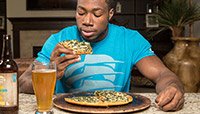
5 Dieting Mistakes You Must Avoid
Nutrition is an essential part of a fit body, but dieting can be a difficult thing to master. If you’re not seeing the results you’re after, you might be making one of these dieting mistakes! Find out what they are and how to fix them.

Figure Athlete To Powerlifter: My First Powerlifting Meet
Earlier this year, I signed up for my first powerlifting meet. Here’s how I trained to put on 10 pounds of muscle, an inch on my quads, and hundreds of pounds on the bar.
Original link:
Protein Cracked: Making A Case For The Egg
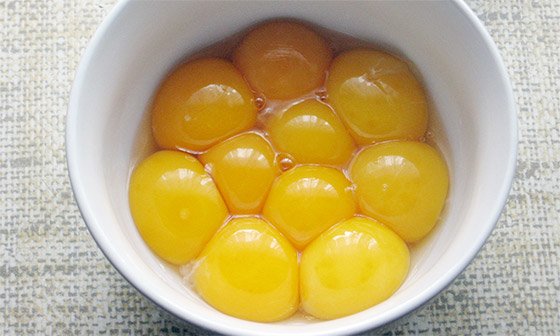

Egg whites are often referred to as the perfect protein, due to their amino-acid makeup and the body’s ability to utilize them properly.
The average large, whole egg contains about 72 calories, 6 g of protein, 5 g of fat, about 200 mg of cholesterol, and nearly no carbs. The average large egg white contains only 17 calories, 4 g of protein, and no carbs, fat, or cholesterol.
Egg whites contain as many as 40 different proteins. Of these, ovalbumin constitutes the majority, making up about 55 percent of the protein in egg white. Ovotransferrin is an iron-binding protein in egg whites that provides antimicrobial properties and makes up over 10 percent of the protein content. Ovomucin is another type of protein that makes up less than 5 percent of egg-white protein and provides the jellying property of egg white, as well as antimicrobial properties.
Egg-white protein is rich in BCAAs and arginine, as well as the sulfur-containing amino acids cysteine and methionine. These amino acids are critical for maintaining the structure of many proteins such as collagen, which is critical for maintaining joint health and levels of certain hormones.
Get Yolked
Although bodybuilders used to focus on just the egg white for protein, and avoided the yolk because of the fat and cholesterol— it’s now known that it’s more beneficial to consume both the egg white and the yolk together. That’s because that golden center contains the majority of the micronutrients in eggs, including vitamin A, vitamin D, vitamin K, B vitamins, selenium, iron, zinc, and phosphorus.

“That golden center contains the majority of the micronutrients in eggs, including vitamin A, vitamin D, vitamin K, B vitamins, selenium, iron, zinc, and phosphorus.”
The yolk also contains all of the egg’s fat and cholesterol, but don’t let that scare you off. Blood cholesterol levels don’t seem to be negatively affected by whole eggs. In fact, one study from the University of Connecticut tested the cholesterol response of 25 males and 27 females to an egg diet (640 mg per day of additional cholesterol) and a non-egg diet (no additional cholesterol). They found the cholesterol in egg yolks does not raise the LDL cholesterol particles that are particularly associated with the development of cardiovascular disease.
We now know that fat is important in a diet. The saturated fat in egg yolks is less than half of the total fat. But saturated and monounsaturated fat, also in egg yolks, are important for maintaining higher testosterone levels. The fat and cholesterol from yolks, which was once thought of as harmful, appears to provide benefits for those who do strength training.
In fact, in a head-to-head egg comparison, consuming more whole eggs was shown to help with muscle gain and strength. The magic number? Three. One study from Texas A&M found that subjects consuming three whole eggs a day while following a weight-lifting program for 12 weeks gained twice as much muscle mass and twice as much strength as subjects eating either just one egg per day or no eggs. Those kinds of benefits may be due to the cholesterol content. After all, cholesterol is converted to testosterone in the body.
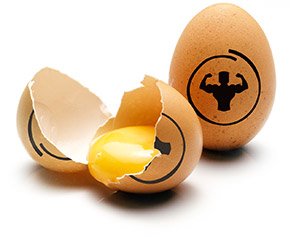
Cholesterol also helps maintain the integrity of muscle cell membranes, which helps them function properly and avoid breakdown. Scientists from Kent State University put 47 older adults (ages 60-69) on a 12-week weight-lifting program, and tested them before and after for changes in muscle mass and strength. They placed all subjects on a moderate protein diet, and divided them into two groups. One group followed a lower-cholesterol diet (1.6 mg per pound of body weight or approximately 150-250 mg per day), while the other half consumed a higher cholesterol diet (2.6 mg per pound of body weight or about 250-450 mg per day). After 12 weeks the group that consumed the lower-cholesterol diet did not increase muscle mass, and only increased their strength by about 35 percent. The higher-cholesterol group, on the other hand, had an increase in muscle mass of about 5 pounds, and upped their strength by about 90 percent.
Drop The Fat
Eggs can also help you get leaner. Research from Saint Louis University found that people who ate eggs for breakfast consumed fewer calories throughout the day than those who had a breakfast with the same amount of calories from a carb-heavy bagel. A follow-up study by the same team found that when women consumed two eggs for breakfast at least five times per week over a 12-week period, they lost 65 percent more weight and had a 34-percent larger reduction in waist size compared to those who skipped the eggs. The study also found that adding two whole eggs to breakfast resulted in no changes in cholesterol levels.
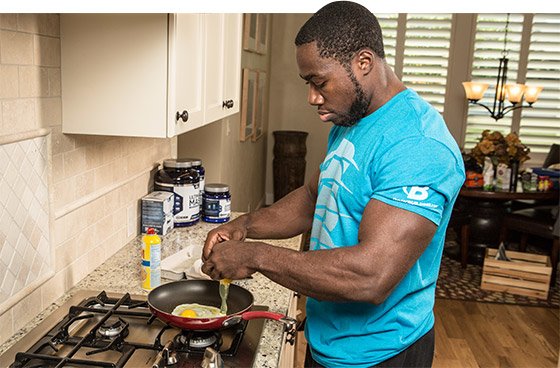
“Research from Saint Louis University found that people who ate eggs for breakfast consumed fewer calories throughout the day than those who had a breakfast with the same amount of calories from a carb-heavy bagel.”
Consider eating two or three whole eggs each day to take advantage of all the benefits eggs have to offer in regard to performance and body composition. You can bump up the protein intake by adding an extra white or two for each yolk.
While eggs are typically thought of as a breakfast food, you can enjoy them anytime throughout the day. Hardboiled eggs work great in salads or as a stand-alone snack. If you really want to kick your eggs up a notch, try my Egg and Ham Cups; they’re delicious and easy to make.
Jim’s Egg And Ham Cups
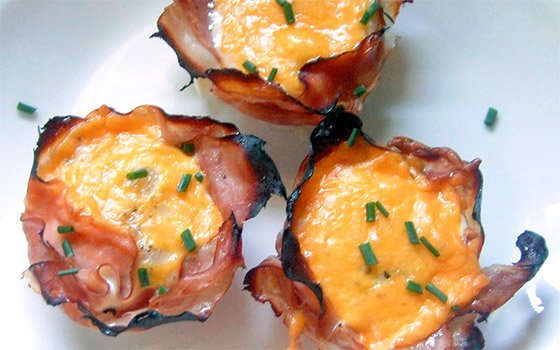
- 1 slice low-fat deli ham
- 1 large egg
- 2 tbsp shredded low-fat cheddar cheese
- 1 slice tomato (optional)
- Preheat the oven to 375°F
- Spray the cups of a muffin tin with nonstick cooking spray.
- Press the sliced ham into the muffin tin cup, forming a ham cup.
- Place the tomato slice in the cup.
- Crack the egg and drop it in on top of the tomato.
- Repeat this process for as many cups as desired.
- Place the muffin tin in the oven and bake for 10-15 minutes, or until the egg is almost cooked.
- Top with cheese and bake for an additional 3-5 minutes, or until the cheese is melted.
- Let cool for a few minutes. Once the cup has cooled, use a spatula to carefully transfer it to a plate.
- Eat with your choice of carbs, such as a piece of fruit, oats, or whole-wheat bread.
 Jim’s Egg And Ham Cups PDF (106 KB)
Jim’s Egg And Ham Cups PDF (106 KB)
Nutrition Facts
Serving Size (1 cup) Recipe yields 1
Amount per serving
Calories 144
Total Fat8 g
Total Carbs2 g
Protein15 g
References
- Yamamoto, T., et al (eds.) Hen Eggs. Their Basic and Applied Science. CRC Press, Boca Raton, FL. 1997.
- Herron, K. L. and Fernandez, M. L. Are the current dietary guidelines regarding egg consumption appropriate? J Nutrition 134:187-190. 2004.
- Herron, K. L. High intake of cholesterol results in less atherogenic low-density lipoprotein particles in men and women independent of response classification Metabolism. 53(6): 823-830, 2004.
- Layman, D.K., et al. Egg Protein as a Source of Power, Strength, and Energy. Nutrition Today 44(1) 2009, 43-48.
- Riechman, S. E., et al. Dietary and Blood Cholesterol and Statins Increase Hypertrophy with Resistance Training. Experimental Biology, San Diego, 2005.
- Dhurandhar, N. V., et al. Egg breakfast enhances weight loss. Experimental Biology Conference, Washington D.C., 2007.
- Vander Wal, J. S., et al. Short-term effect of eggs on satiety in overweight and obese subjects. J Am Coll Nutr. 2005 Dec;24(6):510-5.
- Vander Wal, J. S., et al. Short-term effect of eggs on satiety in overweight and obese subjects. J Am Coll Nutr. 2005 Dec;24(6):510-5.
Recommended For You
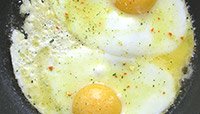
EGGS-actly What You Need To Build Muscle!
How many of you bodybuilders out there enjoy your eggs? Learn why eggs are so important to your diet and how it can help you build muscle!
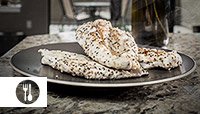
Egg-cellent: 5 Incredible Egg White Recipes
We all want to eat lean protein, but downing egg whites can be a chore. Add some variety to your meals with these egg white recipes!

Become An Egghead: Unscramble Egg Labels And Shop Smart!
When it comes to eggs, there are more differences than whites versus yolks. Get the skinny and buy the right egg!
Read the article:
Best Supplement Stacks For Women – 2014 Holiday Fit Gift Guide
Training and nutrition make up the bulk of a person’s fitness results, but supplements can help push folks in the direction they want to go. We understand that the options can be overwhelming. That’s why we’ve designed stacks—or collections—of supplements that will aid in a specific goal. Whether the goal is to build muscle, burn fat and lose weight, or just look great naked, there’s a supplement stack for people at every level!
1
Women’s Fat Loss 20-30 Stack – Advanced
For the woman in your life, we’ve put together this powerhouse stack to provide fat-burning efficiency and bolster optimal health. Between Jamie Eason Signature Series multi-vitamin and protein, delicious Dymatize protein, FitMiss weight loss support, and NLA fat-shredders, we’ve got all your nutritional bases covered.
2
B-Elite Fuel
As they say, proper nutrition is 80 percent of the weight-loss battle. B-Elite Fuel meal plans help you easily dial in your nutrition and get clean, unprocessed foods into your diet. No messy kitchen, guesswork, food scales, or headaches—just wholesome, easy meals delivered right to your door.
3
ON Women’s Weight Loss
Are you ready to transform your body? Your body will need protein to support new muscle growth, a women’s multivitamin, CLA to help burn fat, and AmiN.O. Energy to inject you with energy to hit the gym hard.
4
Women’s Fat Loss 20-39
Want some help to shed weight post-holidays? We have the perfect combination of supplements to set a strong foundation for your newfound health: Jamie Eason Signature Series Krill Oil, Optimum Nutrition multivitamin, NLA For Her whey protein, and FitMiss Tone for weight-loss support.
5
Her Bizzy Diet
For the woman on the go who still wants to nail her weight management, HerBizzyDiet offers all the nutrition and resources to get or keep you in shape. The stack includes a multivitamin with antioxidants and probiotics, fat-burners, detoxifiers, and a high-protein meal replacement to curb your hunger.
Original post –
Best Supplement Stacks For Women – 2014 Holiday Fit Gift Guide
Best Fitness Accessories For Men – 2014 Holiday Fit Gift Guide
The body is like Batman—just stay with us—and the things that help the body be better at what it does are like Robin. Between Batman and Robin, there’s nothing you won’t be able to handle in or out of the gym! These are the best fitness accessories that will make your fit life even easier.
1
Hydra Cup Dual Shaker Cup
At first, you’re probably like, “Why?” But once you’ve had a taste of separating your water and aminos (or pretty much anything, for that matter) in the same bottle, you’ll wonder how you ever managed without the Dual Shaker in the first place.
2
6 Pack Fitness Pursuit Backpack 6 Pack Bag
Whether you’re heading to a competition or are just out and about on a weekend, carry your meals and snacks around with you in a stylish backpack. The small bag holds up to 3 meals.
3
KT Tape Pro Synthetic Tape
Designed to mimic the human skin, KT tape provides extra healing support for recovering athletes and relieves pain. Read more about KT tape in the article here.
4
TomTom Multisport Watch
Runners, swimmers, and cyclists, meet your ultimate training partner: Engage with your every stride, stroke, or pedal and track your training.
5
GASP Training Belt
Perfect for someone who wants to lift some serious weight but also appreciates superior stability and durability.
6
BlenderBottle ProStak Expansion Pak
Durable, BPA- and phthalate-free jars that provide additional storage for protein powder, pills, and any of your on-the-go nutritional needs. This is compatible with any ProStak shaker cup.
7
Fill-N-Go Funnel
This handy container will help ensure that you never bear the embarrassment or pain of spilling any of your precious protein powder ever again.
8
Super Body Care Gym Bag Deodorizers
Freshen up the funk in your gym bag with a variety of scents that will certainly beat the stank out of sordid gym socks.
9
Polar Loop
Take the stairs, walk across the parking lot, go on a hike—the Polar Loop will keep track of the choices you make throughout the day and remind you to get moving again if you’ve been still for awhile.
10
GASP Branch Wrist Wraps
These wrist wraps provide additional wrist support anytime you need it. A one-size-fits-all wrap with velcro support to easily adjust to your wrist size.
View this article:
Best Fitness Accessories For Men – 2014 Holiday Fit Gift Guide
7 Lessons From The Most Successful Transformations


When pressed for simple solutions to drastic, lasting body transformations, most experts will tell you there are none—that no single workout, diet, or supplement will help you pack on heaps of lean, clean muscle. They’d be right. There isn’t one route to a new physique. There are many.
Once you accept this concept, it’s time to start narrowing your focus. One approach is to scour journals for methods that are known to work in the sterile construct of the lab. The other, better solution would be to take cues from methodologies that have been tested—and decisively proven—in the testing grounds of the kitchen and the gym.
No offense to the experts in lab coats, but the best solutions are always evident in the physiques they produce. Here are some of the transformative lessons learned from people who have gone through dramatic before-and-afters.
1 Recognize The Importance Of Hydration
In a world gone mad with chicken breast, protein powder, and super supps, the importance of water often gets overlooked. Adequate hydration is crucial for maximizing performance, not to mention the regulation of countless bodily systems, brain functions, and general health. Trying to exact measurable change in your body without first addressing fluids is a big mistake. The usual prescription for hard-training athletes is to consume half your body weight in ounces per day.

“Nick Wright, a powerlifter and bodybuilder who started competing when he was 15, recommends putting a system in place that leaves little doubt as to how well your hydration plan is playing out.”
Nick Wright, a powerlifter and bodybuilder who started competing when he was 15, recommends putting a system in place that leaves little doubt as to how well your hydration plan is playing out. “The very first thing I’d recommend for every strength-training enthusiast is to drink close to half a gallon of water as soon as you wake up in the morning, especially if you have heavy lifts coming up,” he says. “Then remain hydrated all throughout the day. Drink an 8-ounce glass of water with every meal and one between every meal. The more hydrated you are, the stronger you will be in the gym, and the safer your joints and tendons will stay.”
2 Go Heavy
Often when someone commits to a new training program, they’re so desperate for change that they cling to higher-rep schemes and longer-than-usual cardio sessions. But the burn-calories-at-all-costs mindset can be disastrous for those who are desperate to become bigger and leaner. Women in particular are sometimes reluctant to handle heavier weight for fear of gaining too much size when this practice is, in fact, a shorter route to a streamlined physique.

“Research shows that heavier lifts more favorably impact testosterone and growth hormone, which have a positive impact on body composition.”
“My favorite tried-and-true tool for building muscle and strength is to put plenty of weight on the bar,” says Jason “Big J” English of Big J’s Extreme Fitness in Red Oak, Texas. “I have been extremely successful with 1-3 working sets of 6-8 repetitions for my primary movements. Just make sure you find your proper weight that is light enough to get to at least six, but is too heavy for 9 or 10 reps.”
Research also shows that heavier lifts more favorably impact hormones such as testosterone and growth hormone, which have a positive impact on body composition.
3 Sleep For a Full Night Every Night

“If you’re not getting enough sleep, you’re just not growing or getting leaner. Period.”
When transformation is your goal, you know you must focus on your training and meals. But it’s important to remember that you don’t grow when you train—you grow when you sleep. That’s when your body takes to the business of putting itself back together; if you’re not getting enough sleep, you’re just not growing or getting leaner. Period. And those who have managed to snap fantastic “after” photos have all come to this realization sooner rather than later.
“When transforming your body, sleep is one of the most important elements in your plan,” says Craig Stevenson, a 20-year veteran of the health-and-fitness industry and vice president of marketing for iSatori. “With the stresses of training, restricted calories, and, in many cases, high levels of stimulants like caffeine, sleep becomes even more important. Reaching delta sleep is vital since that’s when your body releases high levels of hormones like growth hormone. These hormones are critical factors in not only recovery from training, but also in allowing your muscles to grow and fat to be utilized for energy. Having regular habits of when you go to sleep, when you stop consuming caffeine, and when you relax before bed are all key factors in maximizing your sleep and transformation efforts.”
If you train in the evening, make a concerted effort to avoid pre-workout formulas with stimulants within 4-6 hours of bedtime, and try a gradual wind-down routine that provides for 7-9 hours of uninterrupted snoozing each night.
4 Sidestep The Scale
If you set out on a physique revamp, you’re going to want to measure your results and gauge your progress. So should you get on the scale? If so, how often? The science is all over the map on this matter, and anecdotal reports differ greatly from person to person. This is another case where successful individuals may have the most reliable approach.

“Wes Bouillion, iSatori’s most recent Hyper Growth Challenge champion, gained 15 pounds, three inches on his chest, and an inch on his arms in only eight weeks.”
Wes Bouillion, iSatori’s most recent Hyper Growth Challenge champion, gained 15 pounds, three inches on his chest, and an inch on his arms in only eight weeks. No matter which way you’re hoping for the needle to move, he thinks that the scale can be more of a hindrance than a help. “I’m against using a scale to gauge progress unless you have to make weight for a competition,” he says. “Personally, I judge myself on body composition. Remember, body weight can fluctuate daily from bodily fluid alone, and it isn’t the best way to track your results.”
5 Integrate Cross-Training With Your Other Training
Many awesome transformations have been forged without venturing outside the weight room. But sometimes it’s easy to lose motivation if that’s your only environment. Even if your goal is simply to look better in the mirror, the occasional departure from barbells and squat racks can provide welcome mental and physical breaks that can actually speed progress.

“Many awesome transformations have been forged without venturing outside the weight room.”
“I find cross-training motivational because it keeps things fresh and interesting,” says Andrew Balliet, a Colorado-based software engineer who dropped 96 inches in iSatori’s Iron Warrior Challenge. “It makes my body keep guessing at what it needs to handle next, so it’s prepared for the different forms of training and exercises I throw at it. Specifically, I notice cross-training improves sports-performance, from hockey to softball. Cross-training helps keep my core strong for the activities I enjoy outside of the gym.”
6 Supplement Your Meals
Can you get great results by just eating right and training hard? Sure. But training hard taxes your body and, for most people looking to drastically transform, the early phases can leave you wiped. Worse yet, it can leave you beaten down, tired, and sore before building you up to be energized and strong. This can derail you.
Proper, disciplined nutrition goes a long way toward reducing those effects, but supps like protein, bioactive peptides, glutamine, and certain pre-workouts can actually leave you more likely to push through and stick to your routine.
“Supplementation can be a huge benefit, but only after you have nailed down how to eat for your goals,” says Bouillion, who also holds a certification in holistic nutrition from the Institute for Integrative Nutrition. “Supps have helped me tremendously in reaching my goals. It’s like they do double duty because they help me stay lean while I also gain mass. In addition to aiding my recovery, Bio-Gro builds lean mass, while restricting calories. I also use a pre-workout, which gives me more focus and a great pump, and a high-protein meal replacement product. I love the taste, and use it between meals.”
7 Prep Food In Advance
How many “diets” have gone to the graveyard with one too many helpings of chicken and broccoli? How many have failed because of unreasonable deprivation? Meal timing, frequency, and variety all have a tremendous impact in how much progress you’re able to make and how successfully you’re able to stick to your program. It helps to map out a thoughtful strategy ahead of time, according to iSatori CEO Stephen Adele. “Most people spend a considerable amount of time and energy on countless attempts at eating smarter and following weight-loss strategies that inevitably fail,” he says. “They try crazy fad diets, frozen pre-portioned foods, weight-loss clinics, or other quick-fix gimmicks. This is unnecessary and not a practical long-term approach. What is smart, however, is practicing a small set of proven principles over a long period of time.”
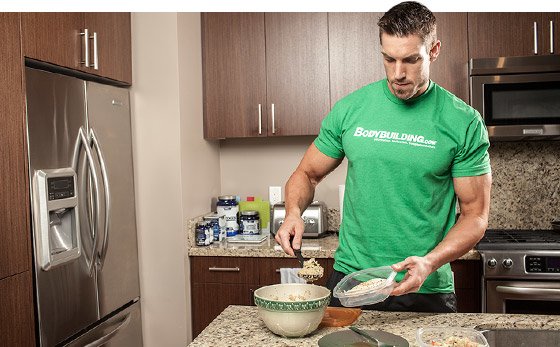
“Meal timing, frequency, and variety all have a tremendous impact in how much progress you’re able to make and how successfully you’re able to stick to your program.”
Adele’s simplest advice? “For me, I don’t like to leave anything to chance, and planning out and preparing my next day’s (and sometimes even week’s) meals is the best way to stay right on course each and every day of your transformation.”
YOUR NEW AFTER
There’s no better time than today to start your physical transformation. Whether you’re a gym novice who wants to lose 10 pounds of body fat, or an expert who wants to gain 10 pounds of muscle, these proven, time-tested principles will guide you through a successful transformation, if you commit to making the change.
Recommended For You

Lose Your Last 10 Pounds – For Good!
Never diet again by incorporating these 10 can’t-miss strategies for permanent weight loss.
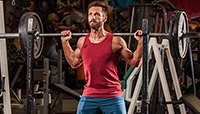
10 Tips For A Successful Transformation
You’re looking to transform, not evolve. You have time, but not forever. Follow these 10 tips and speed up your progress. Let’s go!
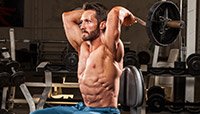
Transform With Muscle: Why Focusing On Fat Loss Isn’t The Answer
Don’t get so wrapped up in losing fat that you forget about muscle. It’s the real key to a successful, lasting transformation!
Read More:
Kris Gethin's Shoulder Annihilation Workout


When I first arrived in India, I had to adapt to a culture that is considerably different than what I was used to, but I’ve wrapped my mind around how life flows here. I’ve settled down and am excited to be part of the country’s growing interest in health and fitness. My hope is to expand the nation’s fitness culture and inspire people to build healthier bodies.
In my mind, there’s no better way to inspire people to train harder and live healthier than to lead by example. Come with me as I smash my shoulders at I Think Fitness in Mumbai. This is one of my favorite shoulder workouts to do. It’s quick, but it’s dirty, and it pumps my delts like nothing else.
During this workout, you’ll learn some of my favorite volume and intensity techniques, as well as some ways to help ensure your delts look good from every angle.
Kris Gethin’s Shoulder Annihilation Workout
Watch The Video – 11:29
![One-Arm Side Laterals]()
![One-Arm Side Laterals]() One-Arm Side Laterals
One-Arm Side Laterals
6 sets of 12, 10, 8, 6, 4, 2 reps one arm at a time-
Note: If you can, increase the weight as you progress through the sets. Rest 45 seconds between sets.
![Alternating Deltoid Raise]()
![Alternating Deltoid Raise]() Lateral Raise to Front Raise
Lateral Raise to Front Raise
6 sets of 12, 10, 8, 6, 4, 2 reps-
Note: Rest only 5 seconds between sets. If you can, go through all 6 sets again.
![Incline Bench Dumbbell Front Raise]()
![Incline Bench Dumbbell Front Raise]() Incline Bench Dumbbell Front Raise
Incline Bench Dumbbell Front Raise
2 sets of 20 reps-
Note: If you can, increase weight for the second set.
![Upright Barbell Row]()
![Upright Barbell Row]() Upright Barbell Row
Upright Barbell Row
2 sets of 10 reps wide-grip, 10 reps medium-grip, 10-reps close-grip-
Note: Try doing more weight and fewer reps on the second set to really blow up your delts.
Post-Workout Nutrition
After you’re done training, make sure to have your post-workout shake. Your body needs the protein and the calories in order to start repairing. Don’t forget that no matter how hard you work in the gym, it’s good nutrition that brings the best results.
Original source –
Best Home Exercise Equipment – 2014 Holiday Fit Gift Guide
Sometimes driving to the gym can be a drag. With these highly recommended pieces of home exercise equipment, you can still get a mean pump without changing into your gym clothes or even leaving the house. Whether your goal is to sculpt a lean and mean body, build solid muscle, or just work up a sweat, these holiday must-haves will make great additions to any home gym.
1
Dual exercise ab wheel
A smart addition to your home gym, or even to travel with. The ab wheel strengthens your core like no crunch or sit-up can.
2
Body-Solid EXM4000S Selectorized Home Gym
The end-all, be-all piece of home gym equipment for the complete commercial gym package without the obnoxious bros.
3
Cap Barbell Medicine Ball
Medicine balls are a classic tool to develop strength, coordination, and endurance. Use it alone or with a partner to build a solid core and stamina.
4
Chin-Up & Pull-Up Bar
Simple and effective way to work out relative body strength without taking up additional space in your home. Just pop it between a doorframe and start getting stronger!
5
ProSource Stackable Resistance Bands
These highly durable and portable bands provide a convenient way to shape and strengthen your body from head to toe.
6
GoFit foam roller
Foam rolling is like a party for your muscles, breaking up scar tissue and tension to keep muscles happy and strong for many gym sessions ahead.
7
PowerBlock Bench/Stand Mat
A seriously affordable bench and accompanying stand mat to build (or add to) a serious home gym.
8
Cap Barbell Kettlebell
Excellent for all-around fitness. If your goal is to work on power and force generation, kettlebells are your ticket to greatness.
9
GoFit Wood Plyobox
Add plyometric exercises to your home workout routine with this wooden platform. Work on explosive box jumps or develop some mean glutes and hamstrings with high step-ups. The possibilities are endless!
10
Harbinger Weighted Vest
Unfortunately, it’s not bulletproof, but at least you can pretend it is and use it to build monstrous strength.
11
PowerBlock Classic 45 Set
Looking for one piece of home gym equipment to buy this holiday season? You’ve found it. Adjustable for up to 45 pounds per hand.
12
SPRI Super Bands
Bands are totally underrated, and so versatile for bodyweight exercises, or even to hook to barbell exercises. Try adding SPRI Superbands to your regimen for a new challenge!
13
GoFit Sand Bag Set
When it comes to building functional strength and muscular endurance, this sandbag set will give you every workout bang for your buck. Develop throwing, passing, and catching skills—get creative!
View this article –
Bodybuilding.com Athlete Recommendations – 2014 Holiday Fit Gift Guide
The athletes of Bodybuilding.com live and breathe a healthy life. Naturally, they can be an expert source for fit gift recommendations. Here’s what some of them have to suggest for the fitness fans in your life.
1
Corey St. Clair – Deep Pocket Pill Organizer
I like to use these to keep all my vitamins and supplements in one place. Plus, they’re great for anyone—no matter their gender, goals, etc. Anyone can put these to good use and make their lives easier while becoming more fit!
2
Jamie Eason – Gym Boss Interval Trainer
The Gym Boss timer is amazing for interval training. It keeps my rest and actual work time on point without having to watch the clock!
3
Nikki Walter – Walden Farms dressings, syrups, and Ketchup
For being calorie-free, Walden Farms’ products are so yummy, especially the pancake syrup! I love putting them on my waffles, pancakes, and everything.
4
Chassidy Smothers – Eco Sweatshirt
I love this sweatshirt beyond words, and think it’s a great gift for yourself. I suppose it’s good for someone else if you can part with it, too! It’s unbelievably soft and comfortable, like your perfect snuggle partner in chilly weather. Looks good, easy to wear on the go, and did I already mention it’s super soft?!
5
Brandan Fokken – Fitmark The Box
Nutrition is at the foundation of my results. For this reason, I make sure I pack what I need with me anywhere I go, and the Fitmark BOX does a great job.
6
Rodney Razor – B-Elite Core Simple
I love the cotton material on these bad boys because it makes them super comfortable to wear!
7
Zane Hadzick – Stackable Resistance Bands
I like these bands a lot because I travel often and it’s great to have them on hand. It makes exercising practical and easy, pretty much anywhere you go. It is really nice when you don’t have a gym accessible. I even use them with my weight training. For example, you can add resistance bands to basic barbell movements for added resistance. Give them a shot!
8
Craig Capurso – B-Elite Turbo-Charged Hoodie
It looks striking, it’s warm, and it’s just great for anytime, anywhere.
9
Brandon Johnson – JayBird Earphones
This is a must-have for my fit life! These earbuds offer great sound quality, are durable, and the best part is, there are no wires!
10
Sara Soloman – Travel RumbleRoller
I was once a physiotherapist, so I understand the importance of adhering to a daily injury-prevention program. I always wrap up my morning exercise sessions with 10 minutes of stretching and foam rolling. My foam roller of choice is the Compact Black Extra Firm RumbleRoller because it’s travel-size and it has “teeth” that help erode my trigger points.
Visit source:
Bodybuilding.com Athlete Recommendations – 2014 Holiday Fit Gift Guide
Best Budget Gifts – 2014 Holiday Fit Gift Guide
Check out our perfect collection of gift ideas under $15, for times when you just don’t feel like breaking the bank but still want to say, “I appreciate you and haven’t removed you from my Christmas list.”
1
Bodybuilding.com Gift Card
Nothing says “Happy Holidays” quite like a gift card for thousands of items that promote and support a healthy lifestyle.
2
Bodybuilding.com Clothing Core Series Core Simple Classic Tee
Rep a clean Bodybuilding.com look in the gym, at the grocery store, or even on your couch.
3
Fitlosophy Fit Tools Kit
The perfect duo for more accurately measuring your progress to get your goals on the right track.
4
GoFit Lightning Jump Rope
Probably the best singular at-home, anywhere-anytime piece of equipment you can get for this steal of a price!
5
Bodybuilding.com Accessories New Wave Enviro Water Bottle
We know you’re thirsty! Our hefty, BPA-free water bottle is perfect for the office, gym, and even day-long hikes.
6
Fill-N-Go Funnel
Beats the snot out of transporting protein powder in Ziplock bags; those can get messy and you can’t quite get the serving you want. Easy-to-use and extremely portable.
7
SkullCandy Chops Bud
Buds to fit your iron-pushing ears, because everybody knows that your chances of surviving a zombie outbreak without a badass soundtrack are bleak at best.
8
Bodybuilding.com Accessories 12 Week Workout Log
Did you know that successfully fit people tend to track and record their workouts? It’s one of the important steps to long-term success, so get one today!
9
Bodybuilding.com Accessories Deep Pocket Pill Organizer
Organize all your multis and supplements in one convenient pill box. Perfect for home or even on the go!
10
VitaMinder Fit & Fresh Smart Portion Chill Containers
Store your leftovers or perfectly portioned meals at the right temperature thanks to included reusable ice packs and secure, snap-on lids.
See original article:
5 Healthy Hummus Recipes


Hummus: the hero of the veggie tray. This ancient, traditional Middle Eastern spread is delicious, and pairs well with just about everything. Although its yummy taste makes it a popular snack choice, hummus is also a wise option because of its nutritional value.
Hummus is made primarily of chickpeas, aka garbanzo beans. And chickpeas are just awesome. They provide a hefty dose of protein—one cup of garbanzo beans contains 15 grams! They’re also a good source of dietary fiber and micronutrients such as copper, manganese, and folate.
By blending chickpeas with other ingredients such as garlic and olive oil, you get the wonderful combination of flavor and health called hummus.
If hummus is a regular in your fridge or it’s your trademark party dish, why not try making your own? You could save some money and get creative. Here are five super-simple, healthy hummus recipes!
1 TRADITIONAL HUMMUS
You can’t go wrong with this traditional hummus recipe. With simple ingredients that produce a fresh, light flavor, this recipe is sure to be a crowd favorite.

- 1 can chickpeas
- 1/3 cup tahini
- 2 tbsp olive oil
- Juice from 1/2 large lemon
- 1 garlic clove
- Blend ingredients.
- Serve with vegetables, pita chips, or snack of your choice.
Nutrition Facts
Serving Size (1/4 recipe) Recipe yields 4
Amount per serving
Calories 280
Total Fat17 g
Total Carbs23 g
Protein9 g
2 PEANUT BUTTER HUMMUS
Now, we know what you’re thinking: Peanut butter hummus? Gross. It may seem strange, but it’s actually a tasty treat! Give it a try and you’ll be surprised.

- 1 can chickpeas
- 1/3 cup creamy peanut butter
- 2 tbsp olive oil
- Juice from 1/2 large lemon
- 1 garlic clove
- Blend ingredients.
- Serve with vegetables, pita chips, or snack of your choice.
Nutrition Facts
Serving Size (1/4 recipe) Recipe yields 4 servings
Amount per serving
Calories 300
Total Fat27 g
Total Carbs27 g
Protein14 g
3 GUACAMOLE HUMMUS
Guacamole is tasty, and so is hummus. Combine the two and you have an epic flavor party! Pair this awesome dip with gluten-free black bean chips and salsa, and you could open up your own restaurant.

- Blend ingredients.
- Serve with vegetables, pita chips, or snack of your choice.
Nutrition Facts
Serving Size (1/4 recipe) Recipe yields 4 servings
Amount per serving
Calories 200
Total Fat9 g
Total Carbs22 g
Protein7.5 g
 Guacamole Hummus PDF
Guacamole Hummus PDF
4 PESTO HUMMUS
This Italian/Middle Eastern fusion will knock your socks off. The excellent flavor combination is unique, and so wonderfully palatable that even kids will like it!

- 1 can chickpeas
- 1/3 cup tahini
- 2 tbsp pesto
- Juice from 1/2 large lemon
- 1 tbsp grated parmesan cheese
- Blend ingredients.
- Serve with vegetables, pita chips, or snack of your choice.
Nutrition Facts
Serving Size (1/4 recipe) Recipe yields 4 servings
Amount per serving
Calories 263
Total Fat13.5 g
Total Carbs24 g
Protein11 g
 Pesto Hummus PDF
Pesto Hummus PDF
5 RANCH-STYLE HUMMUS
Add some parsley, dill, and garlic salt to chickpeas and you have yourself an American taste twist. This recipe has almost no fat and fewer calories than the others recipes, so you can even enjoy it if you’re on a diet.

- 1 can chickpeas
- 1/3 cup nonfat plain Greek yogurt
- 1 tsp dried parsley
- 1/2 tsp garlic salt
- 1 tsp dried dill
- Blend ingredients.
- Serve with vegetables, pita chips, or snack of your choice.
Nutrition Facts
Serving Size (1/4 recipe) Recipe yields 4 servings
Amount per serving
Calories 126
Total Fat1 g
Total Carbs19 g
Protein8 g
Recommended For You

5 Healthy Protein-Packed Spring Salad Recipes
These 5 salad recipes are healthy, full of protein, and are super easy! What more could you ask for?

Your $75 Healthy Grocery List And Recipe Guide!
Not sure you can feed your gains on a limited budget? Learn how to stick to your diet without breaking the bank. Recipes and grocery list included!

Vegan-Friendly Protein Dinner Recipe
If you’re vegetarian or vegan, meeting protein needs can be tough. This protein-packed tofu recipe provides the protein your muscles need and the taste your palate deserves!
Continue reading:
Everything You Know About Corrective Exercise Is Wrong


Corrective exercise is a double-edged sword. On one hand, we all have weaknesses that could benefit from attention. Muscular imbalances, postural issues, and aberrant movement patterns can—and often do—lead to discomfort, pain, and in the worst-case scenarios, injury.
On the other hand, once a trainer sniffs the phrase “corrective exercise,” athletes almost inevitably get this look in their eyes that says, “How about I do Tabata sprints all the way out to my car instead?”
I can’t say I blame them. No one wants to spend 30 minutes activating their glutes—no one. And while having someone stand on a BOSU ball while shaking a body-blade in one hand and juggling oranges in the other may be some people’s definition of corrective or, (excuse me while I throw up in my mouth) “functional,” I’m pretty sure it’s actually a waste of valuable training time.
Athletes don’t want to feel like patients when working out. They want to train! And yet far too often, I’ve seen coaches and personal trainers take an overly cautious approach with clients, thereby failing to elicit the one thing that’s most important: a training effect.
It’s time for a new strategy, where you waste minimal time and get maximum transfer to your performance. Spread the word: Corrective exercise as you know it is dead!
WHAT CORRECTIVE EXERCISE SHOULDN’T BE

This is why, if you research “corrective exercise,” you’re bound to get a kazillion pictures of BOSU balls, stability balls, wobble boards, and other balance-training tools.
Sometimes, our role as a coach or trainer is to pull the reins a bit and help people get out of their own way. But this doesn’t mean we need to begin acting like physical therapists—because we’re not, and very few of us are qualified to pretend we are.
About 10-15 years ago, many coaches and trainers decided to take unstable surface training —a modality popularized in the physical therapy realm for injured people— and apply it toward healthy clients and athletes in a training setting. This is why, if you research “corrective exercise,” you’re bound to get a kazillion pictures of BOSU balls, stability balls, wobble boards, and other balance-training tools.
I don’t want to turn this into a diatribe against training on an unstable surface, because there is a time and place for it. But when applied to—or inflicted upon—healthy individuals in the middle of a workout, all it does is decrease power output, promote faulty movement patterns, and suck energy away from more deserving activities.
So let’s make this absolutely clear: Unless you have a very good reason to do unstable surface training, avoid it. It’s not corrective, and it’s not correct. If necessary, tell your trainer that Uncle Tony gave you a free pass.
GOOD TECHNIQUE
If I had to summarize my point of view in five words, it would be this: Correct movement is corrective exercise!
If coaches and trainers took the time to properly coach their clients and athletes, rather than trying to impress them or make them feel “worked”—i.e., weak—I’m positive they’d see better results.
Likewise, if you take the time to learn how to perform certain movements correctly—which often involves regressing exercises to your current ability—you’ll not only see marked improvements in your overall performance, but also how you look and feel.
Let’s use the squat as an example. My first priority is cleaning up a person’s technique and getting them doing things like:
- Sitting back with the hips
- Pushing their knees out
- Letting the knees move forward slightly
- Engaging the lats by pulling down on the bar
- Not overarching the back
- Finishing the movement with their glutes at the top

Barbell Squat
When you can follow those cues, or by fixing the problems I outlined in my article on common squat mistakes, the squat itself can have profound corrective effects. Yes, we may need to address things like limited ankle dorsiflexion or limited hip mobility, but more often than not, the biggest hurdles can be overcome by simply grooving proper technique. The same goes for rows, chins, deadlifts, Pallof presses, and pretty much all of the other movements I included in my 8-Week beginner plan for Bodybuilding.com.
WHERE THE BORING STUFF FITS
Yeah, about those ankles and hips… I do feel it’s still important to sneak in some traditional corrective exercise, both to address universally problematic areas and for preventative maintenance.
Pretty much everyone has issues with poor glute activation, poor T-spine mobility, limited ankle dorsiflexion, short and tight hip flexors, and poor anterior core engagement. These are just part of living in a civilization that doesn’t do as much as it used to. And yes, this applies to gym rats too.
For this reason, it’s important to include a brief dynamic warm-up prior to each training session, which serves a few purposes:
- It helps improve movement quality.
- It mentally prepares you for your training session.
- When done consistently, it can have a surprising corrective effect over time.
We’re only talking 5-10 minutes of your time here, and yet it can have a profound effect on your performance in the gym and how you feel overall. Here’s one of my favorite one-size-fits-all “corrective” warm-ups.
![Butt Lift (Bridge)]()
![Butt Lift (Bridge)]() Glute Bridge March
Glute Bridge March
10 reps per leg![Quadruped Extension-Rotation]()
![Quadruped Extension-Rotation]() Quadruped Extension-Rotation
Quadruped Extension-Rotation
10 reps per side![Quadruped Extension-Rotation]() Side Lying Windmill
Side Lying Windmill
5 reps per side![Rocking Ankle Mobilization]()
![Rocking Ankle Mobilization]() Rocking Ankle Mobilization
Rocking Ankle Mobilization
10 reps per leg![Yoga Push-Up]() Yoga Push-Up
Yoga Push-Up
10 reps![Step-up with Knee Raise]()
![Step-up with Knee Raise]() High Knee To Forward Lunge
High Knee To Forward Lunge
5 reps per leg![Step-up with Knee Raise]()
![Step-up with Knee Raise]() High Knee To Forward Lunge
High Knee To Forward Lunge
5 reps per leg![Squat To Stand With Reach]()
![Squat To Stand With Reach]() Squat To Stand With Reach
Squat To Stand With Reach
5 reps per side
Squat to Stand with Reach
Watch The Video – 00:07
If you’re too stubborn to even do that, you can use what I like to call “fillers.”
These are mobility drills, activation drills, and stretches that you strategically pair with certain exercises during rest periods. So rather than staring at the television or being Creepy McCreepypants and gazing at your secret crush across the gym floor, you can actually do something productive with your time.
Here are some examples:
-
Superset
![Front Barbell Squat]()
![Front Barbell Squat]() Front Barbell Squat
Front Barbell Squat
4 sets of 5 reps![Lat Stretch]() Lat Stretch
Lat Stretch
3 sets of 20 seconds per side-
Superset
![Barbell Bench Press - Medium Grip]()
![Barbell Bench Press - Medium Grip]() Bench Press
Bench Press
4 sets of 5 reps![Wall Hip Flexor Mobilization]() Wall Hip Flexor Mobilization
Wall Hip Flexor Mobilization
3 sets of 8 reps per leg-
Superset
![Barbell Deadlift]()
![Barbell Deadlift]() Barbell Deadlift
Barbell Deadlift
4 sets of 5 reps![Yoga-Plex]() Yoga-Plex
Yoga-Plex
3 sets of 5 reps per side
Yoga Plex
Watch The Video – 00:13
The key is to use fillers that target areas you know need work, but which won’t interfere with the main movement or inhibit performance in the subsequent sets. Remember, we’re here to get strong, not feel weak!
Recommended For You

The Ultimate Pallof Press Guide
How do you build a stronger, more stable core? It’s not rocket science. First, resist the urge to cave in to fads. Then resist the force imposed on your abs by the Pallof press! Here’s what you need to know.

3 Ways To Improve Your Squat
Progressive overload can only help you for so long on its own. Eventually, you need to battle the weak points in your squat head-on by spending a few weeks with some more difficult variations of the “king of lifts.” Enjoy the pain!
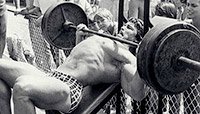
Lift Heavy To Build Muscle Like Arnold Schwarzenegger
Arnold dominated the golden age of bodybuilding with real strength built from heavy lifts. His key to success still applies to most training avenues today!
Read this article:
Supplement Company Of The Month: Twinlab


The history of health and performance supplements couldn’t be written without a big chapter devoted to Twinlab. The company was born in 1968, at the dawn of bodybuilding’s golden age, and it has been setting the benchmark of quality and consistency ever since.
Everyone you know, from your grandma on down the line, has probably taken a Twinlab vitamin or supplement at some point. Check their medicine cabinet, and that telltale amber bottle with the white duotone label will be there.
But now, nearly 50 years into the story, the brand is getting redefined through fresh efforts by Chris Thompson, the company’s VP of Sports Nutrition, and the founder of the company’s powerhouse ProSeries line.
You may know Thompson already if you’ve met him in the Bodybuilding.com forums or watched his Fit 360 profile.
This company has seen it all, and now it wants to see a new generation of athletes and bodybuilders shatter their ideas of what is possible.
Thompson himself, one of the three heads of the popular Twinlab Muscle Militia, gave us the lowdown.
Q Twinlab is a company with a long, storied history. Can you give our readers some insight into your origins?

Chris Thompson: VP of Sports Nutrition, Twinlab
It’s true, Twinlab was there at the very beginning, and we’ve helped shape what became a multibillion-dollar industry. The company was started by the Blechman family in 1968, and named after the fact that they had two sets of twins.
Initially, Twinlab marketed a liquid protein supplement called LPP. After the formula was adopted by bodybuilders as the protein supplement of choice, the company expanded quickly into a large variety of sports nutrition and wellness supplements, and has become one of the largest global players in the industry.
We’ve never strayed from our values of producing top-quality, no-shortcut formulas that deliver results. It’s why we’re still thriving today when many others have burned out and left the market.
This company produces so many different products! How do you keep coming up with new ideas?
The ideas are easy! It’s what makes being part of this industry so interesting. There are always new ingredients, new ideas out there, and ways to improve.
Frankly, the much harder part comes when we have to pick and choose what to launch, but that process helps hone only the best ideas.
Do you have a favorite Twinlab product?
My personal favorite is MVP Fuel. It is without a doubt the best pre-workout available. When other brands were launching “concentrates,” we flipped it and went for full-dosing with ingredients that work, instead of delivering less product to put more money in our wallets.
It’s a source of great pride for me that we didn’t take the bait and shortchange our customers. And sure enough, the market is starting to recognize that you really need full dosing to get the performance you need.
For many of our readers, you are synonymous with the Muscle Militia and Twinlab’s Pro-Series line. What does Pro-Series mean?
We have this saying where, if we’re evaluating something or someone and call it Pro-Series, that’s the ultimate compliment. It means it’s deeply authentic, true, and pure—no show, all go. That’s how we view ourselves, and that’s the standard we hold ourselves to every day.
TWINLAB MUSCLE MILITIA
Watch The Video – 03:12
As for the Militia and our other brand reps, there’s nothing casual about it. Not only do we believe in what we do, it also drives how we eat, how we think, and how we live. It’s a passion and a lifestyle. Many of our sports-dedicated Twinlab reps run their own bodybuilding shows.
They compete themselves, and have clientele they train. I personally respond to thousands of inquiries on the forums and through social media, helping people around the world reach their goals.
Why do so many of your products include the term “fuel?”
We focus on “fuel” for a couple of reasons. First, that’s how we view our products: They are simply tools used to fuel better performance. While many other brands have tried to co-opt the name by using “fuel” in advertising or even their product names, there’s still only one original.
Secondly, it is pure branding. It binds our products together and signals to our customers that they are getting a true Twinlab quality-tested formula.
What new products of yours have been getting the biggest response?
The pipeline is jammed full, so I’ll keep it to two items—even though it kills me to limit myself!
First, Twinlab Pro-Series Vita Fuel. This is an incredible advance in multivitamin and multimineral technology. It’s a bilayer tablet, so the vitamins and minerals are released at different rates. Since water-soluble vitamins simply pass through the body if they’re not needed, to us it only seemed logical that you’d want to release the vitamins over time.
We’ve grown into a real expert in making dual tabs in our own facility. Most others can’t or don’t do it because the equipment is expensive, and it is as much an art as a science.
My second choice would be our all-new MCT Fuel. I just love this product because it’s one of those “secret ingredients” out there that deserves so much more attention than it gets. Medium-chain triglycerides (MCTs) are healthy fats, primarily from coconut oil. They have the inherent energy of a fat, but burn more like a carb, and if the body doesn’t need the energy, it passes through versus being stored.
I love it because it’s old-school and so basic, yet incredibly effective for energy and stamina. Sales of MCT Fuel haves grown steadily for years, and I think our new packaging will help people start to see the importance of adding this into their routine.
Where do you think this company will be in 10 years?
Ahead of the curve, as always. In the past three years we have created new, authentic brands targeting growing niches in the sports nutrition space. Sports nutrition is getting big, and expanding to new audiences.
We want to make sure we don’t abandon our customers for supposedly greener pastures. For example, we launched Pro-Series just this year as a rededication to the elite bodybuilding athlete.
On the other side of the spectrum, we launched CleanSeries for customers who do not want to sacrifice performance for peace of mind. The CleanSeries line has more third-party performance and safety certifications than any other supplement on the market, in any category. We will lead, not follow.
People are becoming less intimidated and more aware of what the products do, and if they stick to reputable brands like Twinlab, they don’t have to be concerned about contamination or adulteration, which are two major obstacles for our industry continuing to expand.
The Internet makes your products available at the push of a button! But, how else do you reach customers? Are there any old-school methods that still work?
Simply put, you need to be where your customers are. That means online, but also in stores, doing demos, at gyms and events, doing interviews and road shows, and certainly making your brand available through social media.
There’s nothing more invigorating to me that talking directly to our consumers. They keep my eye directly on why we’re doing what we’re doing.
Ethics are important to supplements buyers. What does your company do to ensure ethical and quality standards?
This is so simple to answer. It’s doing the right thing. But that doesn’t mean it’s easy.
First, it means that we invest in our own manufacturing plant so we can be the control freaks we want to be. It means we test inbound materials and outbound finished goods to high standards, and unquestioningly reject items that don’t meet those standards, even though we know other companies don’t.
You know, sometimes there’s a reason why some products are priced as low as they are! That’s not good for our customers. That’s not good for Twinlab. That’s not long-term thinking.
What we do only works because we have the best team in the business. That makes the seemingly impossible not only possible, but consistently achieved.
Recommended For You

The Muscle Militia’s Hardest Workouts Of The Year
These 3 workouts left the Muscle Militia Generals gasping, swearing—and smiling. Your muscles will beg for mercy, but the results will speak for themselves!

Full-Body Training: Twinlab Militia 30-Minute Workout
This Twinlab Muscle Militia workout may only last 30 minutes, but it’s a full-body bomb that will challenge each of your major muscle groups to grow. Give it a shot today!

Muscle Manifesto: 5 Principles Of The Lifting Life
A PR is great, but it’s just a number. Strengthen your life from the bottom up, and your lifts will grow alongside it!
Read this article:
Body Transformation: Nick Trebesch, Average Wasn't Good Enough!
![]()
![]()
Why I decided to transform
I had always had a very lean physique, and was blessed with a high metabolism, so it never took much effort to get those “skinny guy abs.” It wasn’t until my high school career ended that I became inspired to make a change in my physique for the better.
I started with a spark of interest to put a little muscle on my skinny frame. I had always been moderately athletic, and had a physique that I thought was fairly average.
How I accomplished my goals
I went to Bodybuilding.com and found so many workout plans, nutrition plans, and so on that I felt overwhelmed with all of the new information I available to me.
I decided to do a trainer, and opted for Steve Cook’s Big Man on Campus trainer. I went at it 100 percent, and left no stone unturned. I really wanted to do it correctly. I followed the trainer religiously: workouts, supplements, and nutrition. It was a big change from my usual habits: just winging it, going to the gym, and paying no mind to my nutrition at all.
Before
After
AGE 18 / HEIGHT 5’9″ / BODY FAT 8%
AGE 19 / HEIGHT 5’10” / BODY FAT 8%
I finished the entire trainer and saw incredible results. These results inspired me further, and within the month I became completely hooked on bodybuilding. That first spark of interest has since turned into a full-on inferno of passion for bodybuilding.
I find inspiration daily in the results I have worked for, and am usually very motivated to go to the gym. However, when I am not, I rely on my gym partner to push me to go and get a good workout in. A good gym partner is one of the best motivational methods for me.
When I didn’t have a gym buddy to help me out, I watched motivational videos. Steve Cook is one of my biggest inspirational figures, and I watched a lot of his videos to help get me in the mindset to go lift.
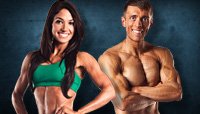
Apply Here To Be A Transformation
Of The Week!
Bodybuilding.com honors people across all transformation categories for their hard work and dedication. Learn how our featured transformers overcame obstacles and hit their goals!
Supplements that helped me through the journey
![Fish Oil]() Fish Oil
Fish Oil
3 tablets daily (morning, afternoon, night)
![Optimum Nutrition Gold Standard Whey]() Optimum Nutrition Gold Standard Whey
Optimum Nutrition Gold Standard Whey
1 scoop first thing in the morning; 1 scoop post-workout; 1 scoop pre-workout
![Creatine Monohydrate]() Creatine Monohydrate
Creatine Monohydrate
2.5 g pre-workout; 2.5 g post-workout
![Hybrid Carb Complex]() Hybrid Carb Complex
Hybrid Carb Complex
4 scoops (50 g) post-workout
Diet plan that guided my transformation
My diet has been a big key to my success. I prep meals every Sunday, so all my food is ready to be heated and eaten at the appropriate time of day.
I always have this many meals, but the types of food I prepare vary.
![Oats]() Oats
Oats
3/4 cup
![Optimum Whey]() Optimum Nutrition Gold Standard Whey
Optimum Nutrition Gold Standard Whey
1 scoop (malt flavor)
![honey]() Organic Honey
Organic Honey
1 tbsp
![Almonds]() Almonds
Almonds
24
![Black Beans]() Black Beans
Black Beans
1/4 cup
![brown rice]() Brown Rice
Brown Rice
1/4 cup
![eggs]() Liquid Egg Whites
Liquid Egg Whites
1/2 cup
![peas]() Peas
Peas
1/3 cup
![Black Beans]() Black Beans
Black Beans
1/4 cup
![brown rice]() Brown Rice
Brown Rice
1/4 cup
![eggs]() Liquid Egg Whites
Liquid Egg Whites
1/2 cup
![Organic Green Beans]() Organic Green Beans
Organic Green Beans
2/3 cup
![Optimum Whey]() Optimum Nutrition Gold Standard Whey
Optimum Nutrition Gold Standard Whey
1 scoop (malt flavor)
![banana]() Banana
Banana
1 large
![yogurt]() Plain Chobani Yogurt
Plain Chobani Yogurt
1 cup
![Almond Breeze Vanilla Almond Milk]() Almond Breeze Vanilla Almond Milk
Almond Breeze Vanilla Almond Milk
1/2 cup
![Optimum Whey]() Optimum Nutrition Gold Standard Whey
Optimum Nutrition Gold Standard Whey
1 scoop
![Hybrid Carb Complex]() Hybrid Carb Complex
Hybrid Carb Complex
4 scoops (50 g) post-workout
![chicken]() Chicken Breast
Chicken Breast
6 oz
![Black Beans]() Black Beans
Black Beans
1/4 cup
![brown rice]() Brown Rice
Brown Rice
1/4 cup
![egg]() Whole Eggs
Whole Eggs
3
![Ground Elk Burger]() Ground Elk Burger
Ground Elk Burger
150 g
![broccoli]() Broccoli
Broccoli
2 cups
Training regimen that kept me on track
The following is my go-to routine. I like to mix things up constantly, however. You will never see me doing the same workout more than two weeks in a row.
![Barbell Bench Press - Medium Grip]()
![Barbell Bench Press - Medium Grip]() Barbell Bench Press – Medium Grip
Barbell Bench Press – Medium Grip
2 warm-up sets of 8-12 reps
5 working sets of 6-12 reps (1 or 2 sets to failure)![Incline Dumbbell Press]()
![Incline Dumbbell Press]() Incline Dumbbell Press
Incline Dumbbell Press
4 working sets of 6-12 reps (last set to failure)![Dumbbell Flyes]()
![Dumbbell Flyes]() Dumbbell Flyes
Dumbbell Flyes
3 working sets of 12-16 reps (last set to failure)![Incline Dumbbell Flyes]()
![Incline Dumbbell Flyes]() Incline Dumbbell Flyes
Incline Dumbbell Flyes
3 working sets of 12-16 reps (last set to failure)![Standing Calf Raises]()
![Standing Calf Raises]() Standing Calf Raises
Standing Calf Raises
2 warm-up sets of 8-12 reps
4 working sets of 6-12 reps (2 sets to failure)![Seated Calf Raise]()
![Seated Calf Raise]() Seated Calf Raise
Seated Calf Raise
4 working of sets 6-12 reps (2 sets to failure)
![Barbell Deadlift]()
![Barbell Deadlift]() Barbell Deadlift
Barbell Deadlift
2 warm-up sets of 6-8 reps
5 working sets of 6-8 reps![Wide-Grip Lat Pulldown]()
![Wide-Grip Lat Pulldown]() Wide-Grip Lat Pulldown
Wide-Grip Lat Pulldown
1 warm-up set of 8-12 reps
4 working sets of 6-12 reps (last set to failure)![Rope Straight-Arm Pulldown]()
![Rope Straight-Arm Pulldown]() Straight-Arm Pulldown
Straight-Arm Pulldown
3 working sets of 12-16 reps (last set to failure)![Seated Cable Rows]()
![Seated Cable Rows]() Wide-Grip Seated Cable Rows
Wide-Grip Seated Cable Rows
4 working sets of 6-12 reps (last set to failure)![Seated Cable Rows]()
![Seated Cable Rows]() Close-Grip Seated Cable Rows
Close-Grip Seated Cable Rows
Triple dropset to failure![Pullups]()
![Pullups]() Pullups (neutral grip, wide grip, then closed grip)
Pullups (neutral grip, wide grip, then closed grip)
3 sets to failure![Rocky Sit-Ups]() Dragon Flag
Dragon Flag
4 sets to failure![Decline Crunch]()
![Decline Crunch]() Weighted Decline Crunch
Weighted Decline Crunch
4 sets to failure![Plate Twist]()
![Plate Twist]() Weighted Oblique Twist
Weighted Oblique Twist
4 sets to failure
![Standing Military Press]()
![Standing Military Press]() Standing Military Press
Standing Military Press
2 warm-up sets of 8-12 reps
4 working sets of 6-12 reps (last set to failure)![Side Lateral Raise]()
![Side Lateral Raise]() Side Lateral Raise
Side Lateral Raise
2 working sets of 12-16 reps
Triple dropset to failure![Front Cable Raise]()
![Front Cable Raise]() Front Cable Raise
Front Cable Raise
4 working sets of 6-12 reps (last set to failure)![Reverse Machine Flyes]()
![Reverse Machine Flyes]() Reverse Machine Flyes
Reverse Machine Flyes
4 working sets of 6-12 reps
Triple dropset to failure![Barbell Shrug]()
![Barbell Shrug]() Barbell Shrug
Barbell Shrug
1 warm-up set of 8-12 reps
5 working sets of 6-12 reps (2 sets to failure)![Standing Calf Raises]()
![Standing Calf Raises]() Standing Calf Raises
Standing Calf Raises
2 warm-up sets of 8-12 reps
4 working sets of 6-12 reps (2 sets to failure)![Seated Calf Raise]()
![Seated Calf Raise]() Seated Calf Raise
Seated Calf Raise
4 working of sets 6-12 reps (2 sets to failure)
-
Superset
![EZ-Bar Curl]()
![EZ-Bar Curl]() EZ-Bar Curl
EZ-Bar Curl
2 warm-up sets 8-12 reps
4 working sets 6-12 reps![Lying Triceps Press]()
![Lying Triceps Press]() Lying Triceps Press
Lying Triceps Press
2 warm-up sets 8-12 reps
4 working sets 6-12 reps-
Superset
![Incline Dumbbell Curl]()
![Incline Dumbbell Curl]() Incline Dumbbell Curl
Incline Dumbbell Curl
4 working sets of 6-12 reps![Seated Triceps Press]()
![Seated Triceps Press]() Seated Triceps Press
Seated Triceps Press
4 working sets of 6-12 reps-
Superset
![Preacher Curl]()
![Preacher Curl]() Preacher Curl
Preacher Curl
4 working sets of 6-12 reps![Triceps Pushdown - Rope Attachment]()
![Triceps Pushdown - Rope Attachment]() Triceps Pushdown – Rope Attachment
Triceps Pushdown – Rope Attachment
4 working sets of 6-12 reps-
![Reverse Barbell Curl]()
![Reverse Barbell Curl]() Reverse Barbell Curl
Reverse Barbell Curl
3 sets of 12-16 reps (1 set to failure)![Rocky Sit-Ups]() Dragon Flag
Dragon Flag
4 sets to failure![Decline Crunch]()
![Decline Crunch]() Weighted Decline Crunch
Weighted Decline Crunch
4 sets to failure![Plate Twist]()
![Plate Twist]() Weighted Oblique Twist
Weighted Oblique Twist
4 sets to failure
![Barbell Squat]()
![Barbell Squat]() Barbell Squat
Barbell Squat
2 warm-up sets of 8-12 reps
5 working sets of 6-12 reps (2 sets to failure)![Hack Squat]()
![Hack Squat]() Hack Squat
Hack Squat
3 working sets of 12-16 reps (last set to failure)![Leg Extensions]()
![Leg Extensions]() Leg Extensions
Leg Extensions
5 working sets of 6-12 reps (last set to failure and dropset on last set)![Stiff-Legged Barbell Deadlift]()
![Stiff-Legged Barbell Deadlift]() Stiff-Legged Barbell Deadlift
Stiff-Legged Barbell Deadlift
2 warm-up sets of 8-12 reps
5 working sets of 6-12 reps (last set to failure)![Seated Leg Curl]()
![Seated Leg Curl]() Seated Leg Curl
Seated Leg Curl
5 working sets of 6-12 reps (last set to failure and dropset on last set)![Standing Calf Raises]()
![Standing Calf Raises]() Standing Calf Raises
Standing Calf Raises
2 warm-up sets of 8-12 reps
4 working sets of 6-12 reps (2 sets to failure)![Seated Calf Raise]()
![Seated Calf Raise]() Seated Calf Raise
Seated Calf Raise
4 working of sets 6-12 reps (2 sets to failure)
What aspect challenged me the most

“I have found success by always keeping my goals in mind, and always putting in that little bit of extra effort.”
Honestly, I embraced the whole challenge very well, and continue to do so. I rarely have days where I am not motivated, or feel like I want to cheat on my diet. It generally works very smoothly.
My biggest obstacle, however, has definitely been defending this lifestyle to my friends and family. I lived on campus for the bulk of my transformation, so there was constant peer pressure to have food that doesn’t fit in my diet, stay up too late, or to drink.
My future fitness plans
I am pursuing a degree in exercise science, and someday aspire to be a personal trainer. I am currently working toward a bodybuilding physique competition one year from now.
Suggestions for aspiring transformers
I find the greatest success in bodybuilding is in embracing the lifestyle. You can go through the grind of “Eat, Sleep, Train, Repeat,” but what good is it doing you if you don’t know where the grind is taking you? I have found success by always keeping my goals in mind, and always putting in that little bit of extra effort, whether it’s putting spinach in your omelet because I know it’s a good antioxidant, or turning my elbows up just the slightest bit on the last rep of my lateral raises.
My favorite quote by Steve Cook speaks a bit to this point: “It has been said, that it’s not where you start, but where you finish. I say, there is no finish line. So learn to enjoy the journey. Endure the sweat, the struggle, the soreness. Embrace the daily grind and give it your all.”
How Bodybuilding.com helped me reach my goals
Bodybuilding.com was a great source of inspiration for me. I got started with the “Big Man on Campus” trainer, and received support from like-minded people on BodySpace. The site is full of articles that almost always pertain to me, and I’ve gained a tremendous amount of fitness knowledge here.
Nick’s Top Gym Tracks
KDrew
Krewella
Aloe Blacc
30 Seconds to Mars
Recommended For You
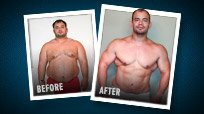
How To Lose 100+ Pounds In 1 Year!
If Steve had downtime, he was either training or preparing meals. That dedicated plan of attack drove him to lose 102 pounds and 30 percent body fat in one year!
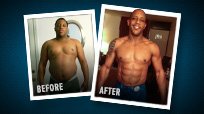
Body Transformation: Eric Hicks Torched 131 Pounds To Reveal Ripped Muscle!
Eric refused to follow his dad’s diabetic fate and committed to change his lifestyle. See how he lost 131 pounds with a healthy mix of training and nutrition!
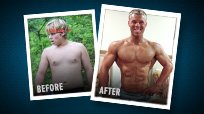
Body Transformation: Micah Van Yperen Went From Pudgy To Pumped Up!
Micah completely changed his body composition as a teen and turned fat to muscle after years of hard work in the gym and kitchen. See how you can too!
More:
Body Transformation: Nick Trebesch, Average Wasn't Good Enough!
The End And Beginning Of The Arctic
This story originally appeared on Ensia.
In the winter of 2013–14, hundreds of milk-white birds with luminous yellow eyes and wingspans of up to 5 feet descended on beaches, farmers’ fields, city parks and airport runways throughout southern Canada and the United States.
Traditionally, snowy owls spend most of their time in the Arctic and subarctic regions. But every four years or so when populations of lemmings — among the owl’s favorite foods — cycle downward, a small number of young, inexperienced birds that are less adept than their elders at hunting will fly farther south than they might normally rather than starve to death. No one, however, had seen an irruption as big and as far-reaching as this one, which was the second major such event in North America in three years.
By the first week of December, the big birds were spotted from North Dakota to Maine and from Newfoundland to Bermuda. At one point, owls collided with five planes at Kennedy, LaGuardia and Newark airports.
Snowy owl irruptions are not in themselves a sure sign that something extraordinary is happening in an Arctic world that is warming nearly twice as fast as the global rate. But given the rapid-fire fashion in which similar, unexpected events have been unfolding throughout the circumpolar region, it’s clear that the Arctic we know is coming to an end, and that a new and very different Arctic is taking over.
What happens in the Arctic matters. The ecological, cultural and economic shifts that are currently underway will not only alter the lives of the Inuit, Gwich’in, Nenets and other aboriginal people who live there, they are likely to affect mid-latitude weather patterns, the migrating birds we see, the air we breathe, the fuel we burn and the way in which we transport goods from one continent to another. The question then becomes, how do we understand and manage the end of the Arctic as we know it so we are prepared to deal with the new Arctic that is unfolding?
A Picture of Change
The past 10 years paint a dramatic picture of climate-related changes at the top of the world. First there were massive forest fires that torched a record 4.2 million hectares of trees in the Yukon and Alaska in 2004. Smoke from those fires could be detected all the way to the east coast of Canada and throughout many parts of the contiguous United States. Parts of the Alaska Highway were shut down for days at a time. Alaskans suffered for 15 days when air quality in cities such as Fairbanks was deemed to be hazardous to health by U.S. Environmental Protection Agency standards.
Then it was the collapse of the 9-mile-long, 3-mile-wide, 120-foot-thick Ayles Ice Shelf off the north coast of Ellesmere Island in 2005. Scientist Warwick Vincent likened the collapse, the largest recorded in the Canadian Arctic, to a cruise missile hitting the shelf after it registered as a small earthquake at a seismic station 150 miles away.

Grizzly and polar bear hybrids like this one are icons of the changes taking place as traditional Arctic habitat disappears. Photo by Jodie Pongracz, Government of the Northwest Territories.
In 2006 we learned of the world’s first wild polar bear–grizzly bear hybrid, of further increases in relatively warm Pacific water flowing north through the Bering Strait, of gray whales overwintering in the Beaufort Sea instead of migrating to the California coast and — from the U.S. National Snow and Ice Data Center — news that September sea ice was declining 8.6 percent per decade or 23,328 square miles per year. At the time, some scientists scoffed when NSIDC research scientist Julienne Stroeve predicted that the Arctic Ocean would have no ice in September by 2060. But when Arctic sea ice retreated to another record low a year later, many suggested September ice might be gone by 2040.
Then came 2007 — the year in which it became crystal clear that winter’s freeze was losing its ability to keep up with summer’s melt. A rare, extraordinarily large tundra fire on the north slope of Alaska accounted for 40 percent of the area burned in the state that summer. Avian cholera, a disease that is common in the south but largely absent in the eastern Arctic, killed nearly one-third of the nesting female common eiders at East Bay, home to the largest colony of the species in the region. It was so warm that summer that the Inuit of Grise Fiord, the most northerly civilian community on the continent, were forced to stockpile sea ice for drinking water because runoff from a nearby glacier dried up.
For the third year in a row, hundreds of beluga whales and narwhal made the mistake of staying in the Canadian Arctic longer than they should have because there was still much open water when summer came to an end. In Lancaster Sound alone, Inuit hunters shot more than 600 belugas that would have otherwise drowned as the small pools of open water they were trapped in shrank to nothing over a 10-day period.
But what really made the big melt of 2007 an eye-popping one was the absence of ice in areas where it almost never thaws. The so-called “mortuary” of old ice that perennially chokes M’Clintock Channel in the High Arctic of Canada virtually disappeared that August. The “birthplace” of a great deal of new ice that is manufactured in Viscount Melville Sound to the north was down to half of its normal ice cover. “The ice is no longer growing or getting old,” said John Falkingham, chief forecaster for the Canadian Ice Service.

Massive chunks of ice broke from the warming Petermann Glacier in Greenland in the summer of 2012.
Extraordinary as the events of 2007 were, the changes that have been brought on by a rapidly warming Arctic have not let up since then. In 2010 and 2012, 100 square miles and 46 square miles respectively broke away from the Petermann Glacier in Greenland. The presence of so much warm open water in 2012 — when another record low for sea ice cover was established — fueled an unusually powerful summer cyclone that tore through the Arctic for nearly two weeks.
It wasn’t just sea ice that was being churned up and melted more quickly by these increasingly powerful storms. In the Yukon-Kuskokwim delta in Alaska, which is already vulnerable to rising sea levels, storm surges sent waves of saltwater more than 30 kilometers inland on three occasions between 2005 and 2011. This doesn’t bode well for the million birds that nest in the delta nor for the Chinook (king) salmon, which have been in steep decline in the region for more than a decade. This year’s run of between 71,000 and 117,000 was expected to be as poor as last year’s, which established a record low.

In an ominous positive feedback loop, a recently discovered crater in the thawing Siberian permafrost is spewing methane, a potent greenhouse gas, into the atmosphere. Photo by Marya Zulinova, press service of the Governor YaNAO.
Even among all this, one of the most recent signs of change has been especially alarming. All across the Arctic, scientists have been detecting abnormally high concentrations of methane seeping out of the thawing permafrost. In one spectacular example discovered along Siberia’s Yamal Peninsula in 2014, concentrations of the greenhouse gas 50,000 times higher than the atmospheric average were found to be rising from a 200 feet deep crater that was formed when a massive sheet of permafrost thawed and collapsed. In another case in Canada’s western Arctic, three of many seeps found in the area were found to be emitting as much greenhouse gases in a year as are emitted by 9,000 average-sized cars.

Unable to find sufficient sea ice to lie on, thousands of walrus took to the shores of the Chukchi Sea in September 2014. Photo by Corey Accardo, AP/NOAA.
We are already seeing the effects of some of these changes ripple through various ecosystems. Capelin, not arctic cod, is now the dominant fish in Hudson Bay. Killer whales, once stopped by sea ice, are now preying on narwhals and beluga whales throughout the Arctic Ocean. Pacific salmon of all types are moving into many parts of the Canadian Arctic where they have never been seen before. Polar bears at the southern end of their range are getting thinner and producing fewer cubs than they have in the past. Chukchi Sea walrus are hauling out on land by the tens of thousands, as 35,000 of them did in September 2014 when there was no more sea ice to use as platforms.
The changes that are occurring are circumpolar. In the Norwegian archipelago of Svalbard, fjords on the west coast have not been frozen for several years. Tundra there is being overtaken by shrubs, just as it is in Siberia, Chukotka, Arctic Canada and the north slope of Alaska where barren ground caribou — fixtures on the summer tundra — are dramatically declining. According to the CircumArctic Rangifer Monitoring and Assessment Network, which is run on a voluntary basis by veteran biologists Don Russell, Anne Gunn and others, half of the world’s 23 barren ground caribou herds that are routinely counted are in decline. Only three, maybe four, are increasing, and they are doing so only modestly. Measured another way by biologists Liv Vors and Mark Boyce, who included the fate of boreal forest and mountain caribou in their survey, 34 of the 43 major herds scientists have studied worldwide in the past decade are in a free-fall.
Flash Forward
If the past tells us anything about the future, it’s that there will be many more changes that were not anticipated. A few things, however, we know with some degree of confidence.
First, temperatures will continue to rise, resulting in the Arctic Ocean being seasonally ice-free by 2040 or possibly earlier. Two-thirds of the world’s polar bears will be gone a decade later, as will one-third of the 45,000 lakes in the Mackenzie, one of the largest deltas in the Arctic.
In 2100, when trees and shrubs overtake much of the grasses and sedges on the tundra, what we think of as traditional habitat for barren ground caribou will have shrunk by as much as 89 percent. Coniferous forests will be replaced by deciduous ones in many places. Some trees will have begun to take root on the south end of the Arctic Archipelago. Most of the polar ice caps on Melville Island will have melted away.
And summer storms in the Arctic will continue to pick up steam as melting ice and warming waters contribute to further rises in sea levels. The pounding these storms inflict on frozen shorelines will accelerate the thawing of permafrost which currently traps massive amounts of methane. The Arctic Ocean will continue to acidify as its upper surface absorbs the carbon dioxide that continues to be emitted from both the ground and from the burning of fossil fuels.
The future is not necessarily all doom and gloom, however. There is compelling evidence to suggest that some subarctic and Arctic animals — such as the bowhead whale, the musk ox and the barren ground grizzly bear — will likely thrive in this warmer world. So, too, may the wood bison, which emerged from the 19th century greatly diminished in the subarctic due to habitat loss and overhunting before animals were reintroduced to parts of the Northwest Territories, the Yukon, Siberia and Alaska. There are even signs that cougars could stage a comeback in a land in which the maneless Beringian lion once preyed on animals such as the saiga antelope.
Still, as daunting as the future Arctic looks to be, it may in fact be much worse. What we think we know about the future of the region may be grossly underestimated because scientists are uncomfortable talking about or putting pen to predictions that are not backed by 95 percent certainty.
Benjamin Abbott and University of Florida researcher Edward Schuur anonymously surveyed climate and fire experts in 2013, asking them how much boreal forest and tundra will burn in the future. Nearly all respondents painted a picture that is much worse than what most experts had publicly claimed. In a “business-as-usual” scenario, they predicted that emissions from boreal forest fires will increase 16 to 90 percent by 2040. Emissions from tundra fires will grow even more rapidly.
As much as we know and think we know about what the future Arctic might look like, it’s what we don’t know that worries scientists like Henry Huntington, co-chair of the National Research Council committee that recently examined emerging research questions in the Arctic. “Many of the questions we’ve been asking are ones we’ve been asking for some time,” says Huntington. “But more and more, there are new questions arising from insights that have been made only in recent years, or phenomena that have only begun to occur.”
Growing Wealth, Shrinking Cooperation
All together, the changes past and present in the Arctic paint a picture of a future unfolding with potentially large economic and geopolitical ramifications.

As shipping lanes open in the Arctic, cargo ships will become more common sights.
Receding sea ice, for example, is revealing 22 percent of the undiscovered, technically recoverable hydrocarbon resources in the world, as well as the potential for a commercial fishing industry. It is opening up shipping lanes that are far shorter and economical than existing routes that must pass through the Panama and Suez canals.
This will prove to be challenging. Most of the Arctic currently belongs to the five coastal Arctic states — the United States, Canada, Russia, Norway and Denmark Greenland. But a big part of it — the so-called 1.2 million-square-mile “donut hole” in the central Arctic Ocean — does not fall under any country’s jurisdiction.

Receding sea ice is opening new channels for commercial fishing in the Arctic.
Until recently, security issues, search and rescue protocols, indigenous rights, climate change, and other environmental priorities were the main concerns of the Arctic Council, an intergovernmental forum that includes the eight voting states bordering the Arctic and several indigenous organizations that have participant status. But the recent admission of China and other major Asian economic powers as observer states is yet another strong sign that the economic development of an increasingly ice-free Arctic is becoming a top priority of nations in the region and beyond.
As this interest in the Arctic’s future wealth grows, willingness to cooperate and compromise may shrink.
The United States, for example, continues to challenge Canada’s claim that the Northwest Passage is part of its inland waters and not an international strait. Nor does the United States recognize Canada’s claim to a small resource-rich region in the Beaufort Sea. In the meantime, Canada and Denmark have agreed to disagree over the ownership of Hans Island in the eastern Arctic as they continue to work out a tentative agreement on the maritime boundary in the Lincoln Sea. And Russia continues to flex its military might in the Arctic in a way that has NATO allies concerned.
On the positive side, the current process of dividing up the unclaimed territory in the Arctic may well be resolved by protocols set forth by the United Nations Convention of the Law of the Sea. The five coastal Arctic states have been spending hundreds of millions of dollars mapping the Arctic Ocean floor to make a case for extending their territories northward. But the recommendations that will eventually be put forth are likely to come in the distant future and they are not legally binding.
Alternatively, there may be some hope, because headway has been made in the development of an international fisheries agreement that would protect the waters of the central Arctic Ocean.
The dark horse in all this is China, which as an exporting nation and major energy consumer stands to gain from shorter trade routes through the Arctic and from the energy resources there that remain largely unexploited. It may or may or may not play along with the Arctic Council’s current efforts to focus on sustainable economic development and environmental protection in the Arctic. A Canadian think-tank — the Macdonald-Laurier Institute — recently suggested that China’s true intentions in the Arctic may amount to “positioning itself to influence heavily, if not outright control, the awarding of select Arctic energy and fishing-related concessions as well as the rules and political arrangements governing the use of strategic waterways now gradually opening due to melting ice.”
Now What?
With all of this in mind, what should be done?
One clear course of action is to halt the activity giving rise to the change — fossil fuel consumption and the release of methane gas as permafrost thaws and sea ice melts. Given the pace of change and the long lag time, however, there is very little that can be done to stop the Arctic from warming in the short term. Humans have already released so much greenhouse gas that even if we stop right now, it will take centuries to halt or reverse the decline of sea ice cover, the thawing of permafrost, the meltdown of glaciers and the acidification of the Arctic Ocean, which is directly attributable to the increase in emissions.

Receding sea ice in the Arctic is revealing 22 percent of the undiscovered, technically recoverable hydrocarbon resources in the world. But offshore oil and gas development brings with it environmental risks. (AFP Photo/Greenpeace/Tim Aubry).
New economic opportunities may arise from oil and gas developments and commercial shipping, but those economic benefits could be offset by a blowout or shipping accident that could prove to be even more catastrophic than the Exxon Valdez disaster and BP’s Deep Water Horizon. Unlike Prince William Sound or the Gulf of Mexico, there is ice in the Arctic and no ports and few runways from which to stage a cleanup. There is also no practical way of separating oil from ice. There is, therefore, a need to develop technologies to increase safety of oil and gas extraction before exploration and extraction proceeds. There is also a need to identify and protect biological hot spots that are vulnerable to this kind of human activity.
One of the biggest challenges in planning for the future is to figure out what the new Arctic (including the sub-Arctic) might look like. Against a backdrop of boreal forest, tundra, permafrost, polar deserts, glaciers, ice caps, mountains, rivers, deltas, sea ice, polynyas, gyres and open ocean, that won’t be easy to do. There are thousands of pieces to this puzzle. They include the 21,000 cold-climate mammals, birds, fish, invertebrates, plants and fungi we know a lot about. They also include countless microbes and endoparasites that remain largely a mystery. Further discoveries of microscopic creatures new to science, such as the picobiliphytes found in the Arctic in 2006, are inevitable.
A rigorous assessment of what the future might look like could help decision makers understand who the winners and losers will be in a future Arctic and what other surprises we can expect. This will help identify which low-lying Arctic communities need to be shored up, moved or made fire safe. It could guide decision-makers in designing better rules and regulations for pipelines and resource development and for commercial shipping. It could also help decision-makers better understand, predict, mitigate and adapt to both changes in the Arctic itself and trickle-down effects to temperate regions.
This is already being done with some success on a small scale. A program in Old Crow, the most northerly community in the Yukon, for example, successfully paired scientists with community leaders to address the issue of food security in a quickly changing climate. Similarly, in Alaska, the Landscape Conservation Cooperatives have facilitated partnerships between the U.S. Fish and Wildlife Service and other federal agencies, states, tribes, non-governmental organizations, universities and stakeholders within a number of ecologically defined areas.
What the Arctic really needs, in addition to these and other small-scale initiatives, is international cooperation either through an overarching treaty or through a series of binding agreements. The issues are too big, too complex and in many cases too overlapping to be left to individual countries to address. In order for this to happen the role of the Arctic Council needs to be strengthened. Science needs to be funded much better than it has been, the indigenous people of the Arctic must be equal partners in the decision-making process, and non-Arctic countries such as China must be included in the conversation.
The future of the Arctic is not necessarily completely bleak. But if we continue to ignore or underestimate the changes that are taking place in this part of the world, it will, as climatologist Mark Serreze bluntly said in 2009, “bite us [and] bite hard.”
Source:
Guy Dances To ‘Push It’ Like No One’s Watching, Even Though Everyone Is


There’s really no question this guy pushed it.
In a video uploaded to YouTube, a man gives it his all, dancing to Salt-N-Pepa’s “Push It.” Others on the dance floor look on, probably crazy jealous that they can’t break it down like he can.
Watch at the 0:42 mark when he goes into full beast mode, showing everyone else on the dance floor that there is just absolutely no shame in his game.
We commend you, sir. Now, go dance your heart out.
H/T: Distractify
Read this article –
Guy Dances To ‘Push It’ Like No One’s Watching, Even Though Everyone Is















